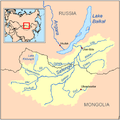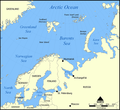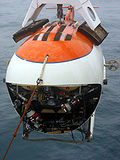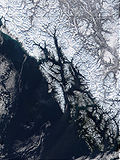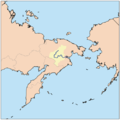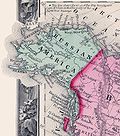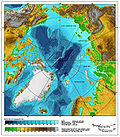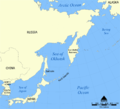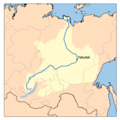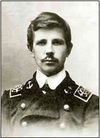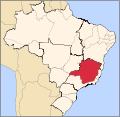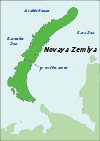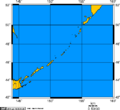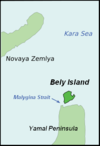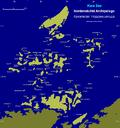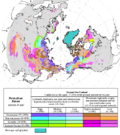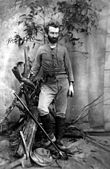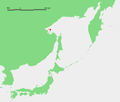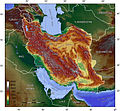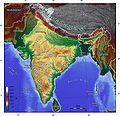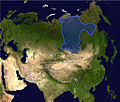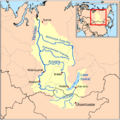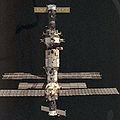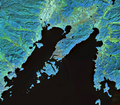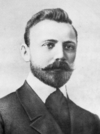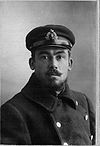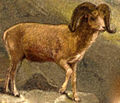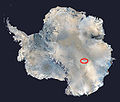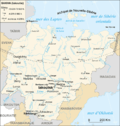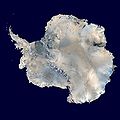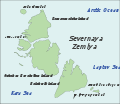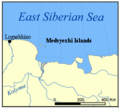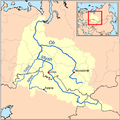- List of Russian explorers
-
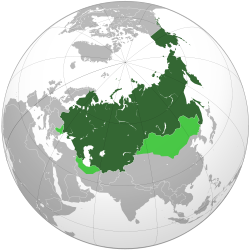 The Russian Empire at its peak in 1866, including the spheres of influence; this territorial expansion largely corresponds to the extent of contiguous exploration by Russians.
The Russian Empire at its peak in 1866, including the spheres of influence; this territorial expansion largely corresponds to the extent of contiguous exploration by Russians.
This is a list of explorers from the Russian Federation, Soviet Union, Russian Empire, Tsardom of Russia and other Russian predecessor states, including ethnic Russians and people of other ethnicities. This list also includes those who were born in Russia but later emigrated, and those who were born elsewhere but immigrated to the country and participated in its exploration activities.
At 17,075,400 square kilometres (6,592,800 sq mi), Russia is the largest country in the world, covering more than a ninth of the Earth’s land mass. In the times of the Soviet Union and the Russian Empire the country's share in the world's land mass reached 1/6. Most of these territories were first discovered by Russian explorers (if, of course, we don't count indigenous peoples of inhabited territories). Apart from their discoveries in Siberia, Alaska, Central Asia and the Extreme North, Russians have made significant contributions to the exploration of the Arctic and Antarctic, the Pacific islands, as well as deep-sea and space exploration.
For the full plain list of Russian explorers on Wikipedia, see Category:Russian explorers. See also the list of Russian and Soviet cosmonauts; several cosmonauts, who've set important records, are listed here.
Alphabetical list
- Areas primarily explored
Siberia/the Far East Alaska/North Pacific Europe Tropics Arctic/the Far North Antarctic/South Pacific Central Asia Space Contents: Top · 0–9 A B C D E F G H I J K L M N O P Q R S T U V W X Y Z
A
Portrait Person Achievements Image Valerian Albanov
(1881–1919)
 Russian Empire
Russian Empire
Imperial Russian Navy officer, lieutenant, Arctic explorerAlbanov was one of the only two survivors of the ill-fated 1912-14 Brusilov expedition, the other being Alexander Konrad. They left ice-bound ship St. Anne and by ski, sledge, and kayak crossed the Kara Sea, reached Franz Josef Land and finally were rescued by Georgy Sedov's Saint Phocas. The data about ice drift of St. Anna, provided by Albanov, helped Vladimir Vize to calculate the coordinates of previously unknown Vize Island.[1]
A glacier in Severnaya Zemlya is named after Albanov. Either Albanov or Konrad is a prototype for a hero in the novel The Two Captains by Veniamin Kaverin.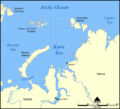 The Kara Sea
The Kara Sea
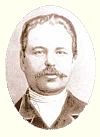
Pyotr Anjou
(1796–1869)
 Russian Empire
Russian Empire
Imperial Russian Navy officer, Admiral, hero of the Battle of Navarino, Arctic explorerIn 1820, as a lieutenant, Anjou described the coastline and the islands of Eastern Siberia between Olenek and Indigirka rivers and mapped the New Siberian Islands. In 1825-26 he participated in describing the northeastern coast of the Caspian Sea and the western coast of the Aral Sea.[2]
Anjou Islands, the largest group in the New Siberian Islands, bear Anjou's name.Danila Antsiferov
(?–1712)
 Tsardom of Russia
Tsardom of Russia
Siberian Cossack ataman, explorer of Kamchatka and Kuril IslandsDanila Antsiferov was elected Cossack ataman on Kamchatka after the death of Vladimir Atlasov. He was one of the first Russians to visit Kuril Islands and describe them in writing, including Shumshu and Paramushir Island.[3]
A cape and a volcano on the Paramushir Island and one of the Kuril Islands bear Antsiferov's name.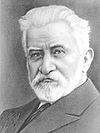
Dmitry Anuchin
(1843–1923)
 Russian Empire
Russian Empire
 Soviet Union
Soviet Union
geographer, anthropologist, ethnographer, archaeologist, explorer of European RussiaIn 1880 Anuchin researched Valday Hills and Lake Seliger. In 1894-95, joining the expedition of Alexei Tillo, he again studied Valday. Anuchin finally determined the location of the source of Volga, the largest European river. He published a major work about the relief of European Russia and founded the Geography Museum at Moscow State University.[4]
Anuchin crater on the Moon, a glacier in Novaya Zemlya, one of the Kuril Islands, a mountain in Ural and Anuchin Institute of Anthropology of Moscow State University are named after Anuchin.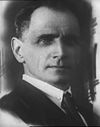
Vladimir Arsenyev
(1872–1930)
 Russian Empire
Russian Empire
 Soviet Union
Soviet Union
military topographer, explorer of the Far East, writerArsenyev wrote a number of popular books about his journeys to the Ussuri basin in 1902-07, where he was accompanied by Dersu Uzala, a native Nanai hunter. Arsenyev was the first to describe numerous species of Siberian flora; he produced some 60 works on the geography, wildlife and ethnography of the regions he traveled. In 1975, the joint Japanese-Soviet movie Dersu Uzala by Akira Kurosawa won the Oscar for the Best Foreign-Language Film.[5]
A glacier on volcano Avachinskaya Sopka and Arsenyev town in Primorsky Krai are named after Arsenyev. Dersu Uzala, photo by Arsenyev
Dersu Uzala, photo by Arsenyev
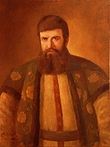
Vladimir Atlasov
(1661–64 – 1711)
 Tsardom of Russia
Tsardom of Russia
Siberian Cossack ataman, explorer of Kamchatka, Kuril Islands, Chukotka and JapanAtlasov established the first permanent Russian settlements on Kamchatka Peninsula and led its colonisation. He was the first to present a detailed description of the region's nature and people, and also accounted on the lands near Kamchatka – Chukotka and Japan. Atlasov brought Dembei, a shipwrecked Japanese merchant, to Moscow, where he become the first to teach Japanese to Russians.[6]
Atlasov Island off the southern tip of Kamchatka, a bay and a volcano on Kuril Islands are named after Atlasov.B
Contents: Top · 0–9 A B C D E F G H I J K L M N O P Q R S T U V W X Y Z
Portrait Person Achievements Image Mikhail Babushkin
(1893–1938)
 Russian Empire
Russian Empire
 Soviet Union
Soviet Union
military pilot, polar aviator, Hero of the Soviet Union
(a monument in Moscow)Babushkin took part in an a expedition to rescue Umberto Nobile in 1928, and in the rescue of SS Chelyuskin crew in 1933. He performed the flights to the first drifting ice station North Pole-1 in 1937. In 1937-38 he participated in a search for Sigizmund Levanevsky.[3]
A district and a street of Moscow (in the area where he was born) and the Babushkinskaya station of the Moscow Metro are named after Babushkin. SS Chelyuskin sinking
SS Chelyuskin sinking

Konstantin Badygin
(1910–1984)
 Russian Empire
Russian Empire
 Soviet Union
Soviet Union
Soviet navy officer, writer, scientist, Arctic explorer, Hero of the Soviet Union
(Badygin left, Sedov's mechanic D.G. Trofimov right on the Soviet postage stamp)In 1938 Badygin became the captain of the ice-captured icebreaker Sedov, turned into a kind of drifting ice station. Most of the crew was evacuated, but 15 sailors and scientists, including Vladimir Vize, stayed aboard and carried out a valuable scientific research during their 812 days on Sedov. After drifting from New Siberian Islands across the North Pole, they were finally freed between Greenland and Svalbard by icebreaker Joseph Stalin in 1940.[7][8]  Icebreaker Sedov on the Soviet postage stamp
Icebreaker Sedov on the Soviet postage stamp
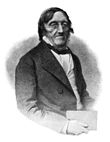
Karl Ernst von Baer
(1792–1876)
 Russian Empire
Russian Empire
(born in Estonia, Baltic German descent)
naturalist, a founder of embryology, explorer of European Russia, Northern Europe and ArcticA prominent naturalist, Karl Ernst von Baer was also an explorer. In 1830-40 he researched Arctic meteorology. He was interested in the Northern part of Russia and explored Novaya Zemlya in 1837 collecting specimens. Other travels led him to the North Cape, Lapland, and the Caspian Sea. After his explorations of Volga he formulated the geological Baer's law, stating that in the northern hemisphere erosion occurs mostly on the right banks of rivers, and in the southern hemisphere on the left banks. Baer was one of the founders of the Russian Geographical Society in 1845, and also a co-founder and the first President of the Russian Entomological Society.[4]
Baer Island in the Taymyr Gulf of the Kara Sea is named after Karl Baer. Library of the Russian Geographical Society in 1916
Library of the Russian Geographical Society in 1916
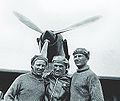
Georgiy Baidukov
(1904–1994)
 Russian Empire
Russian Empire
 Soviet Union
Soviet Union
 Russian Federation
Russian Federation
aircraft test pilot, Hero of the Soviet Union
(Baidukov, Chkalov and Belyakov in 1937)Baidukov was involved in a number of Soviet ultralong flights. In 1936 Valery Chkalov, Baidukov and A.V.Belyakov on ANT-25 flew 9,374 km from Moscow through the North Pole to follow-up Chkalov Island in Okhotsk Sea, which took 56 h 20 min. In 1937, also on ANT-25, the same crew flew 8,504 km from Moscow through the North Pole to Vancouver, Washington, which was the first transpolar flight between Europe and North America on airplane, rather than on dirigible.[9]
Baydukov Island near Chkalov Island in the Okhotsk Sea and a number of streets are named after Baidukov.
Alexander Baranov
(1746–1819)
 Russian Empire
Russian Empire
merchant in Siberia and Alaska, first Governor of Russian AmericaBaranov was hired to head the Shelikhov-Golikov Company, which was in 1799 transformed into Russian-American Company. Thus Baranov became the first Governor of Russian America and held this post in 1799-1818. He explored the coast areas of northwestern North America, helped Russian Orthodox missionaries and improved relations with Alaska natives. He established trade with China, Hawaii and also with California, where he founded Fort Ross.[10]
Baranof Island in Alaska and U.S. liberty ship SS Alexander Baranof have been named after Baranov. Fort Ross in California
Fort Ross in California
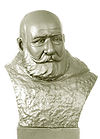
Nikifor Begichev
(1874–1927)
 Russian Empire
Russian Empire
 Soviet Union
Soviet Union
Russian Imperial Navy officer, Arctic explorer
(forensic facial reconstruction)Begichev was the bosun of ship Zarya, carrying Baron Eduard Toll's expedition in 1900-03. In 1922, at the request of Norway, Begichev led a Soviet expedition in search for lost crew members of Roald Amundsen's 1918 expedition on ship Maud Peter Tessem and Paul Knutsen, but he was not successful. In 1923-24.Begichev explored the Taymyr Peninsula with Nikolay Urvantsev.[11][12]
Bolshoy Begichev Island and Maliy Begichev Island, explored by Begichev, have been named after him.
Pyotr Beketov
(c. 1600 – c. 1661)
 Tsardom of Russia
Tsardom of Russia
Siberian Cossack voevoda, explorer of Zabaykalye and Yakutia
(a monument in Chita)Beketov, initially a strelets, was appointed Enisei voevoda in Siberia after 1627. He successfully carried out the voyage to collect taxes from Zabaykalye Buryats, becoming the first Russian to step in Buryatia. He founded there the first Russian settlement, Rybinsky ostrog. Beketov was sent to the Lena River in 1631, where in 1632 he founded Yakutsk, a startpoint of further Russian expeditions eastward. He sent his Cossacks to explore Aldan and Kolyma rivers, to found new fortresses, and to collect taxes. In 1652 he launched another voyage to Buryatia, and in 1653 Beketov's Cossacks founded follow-up Chita and then future Nerchinsk in 1654.[13] 
Alexander Bekovich-Cherkassky
(?–1717)
 Tsardom of Russia
Tsardom of Russia
(Circassian origin)
Russian officer, explorer of Central AsiaBekovich-Cherkassky, a Circassian Muslim converted into Christianity, was made by Tsar Peter I the leader of the first Russian military expeditions into Central Asia in 1714-17, with the aim to conquer the Khanate of Khiva and the golden sands of the Oxus River. Bekovich received these orders in Astrakhan, where he was engaged in preparing the first Russian map of the Caspian Sea. He commanded a preliminary expedition to Turkmenistan and set up the forts in Krasnovodsk and Alexandrovsk. In 1717 he won the battle against Khivan Khan, but was tricked into separating his men, betrayed by Khan, defeated and killed.[14] 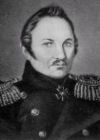
Fabian Gottlieb von Bellingshausen
(1778–1852)
 Russian Empire
Russian Empire
(born in Estonia, Baltic German descent)
Russian Imperial Navy officer, circumnavigator, Antarctic and Pacific explorerBellingshausen took part in the first Russian circumnavigation under Ivan Krusenstern on Nadezhda in 1803-06. He led himself another Russian circumnavigation in 1819-21 on the corvette Vostok, together with Mikhail Lazarev on Mirny – this expedition was the first to discover the contenent of Antarctica on January 28, 1820 (New Style). They also discovered and named Peter I Island, Zavodovski, Leskov and Visokoi Islands, Antarctic peninsula mainland and Alexander Island (Alexander Coast), and made some discoveries in the tropical waters of the Pacific.[15][16]
Bellingshausen Island in the Atlantic, Bellingshausen Sea, Bellingshausen Station, Bellinshausen Island in the Pacific, Faddey Islands in the Arctic, ancient Bellingshausen Plate, Bellinsgauzen crater (Moon) and minor planet 3659 Bellingshausen are named in honor of Bellinsgausen.
Lev Berg
(1876–1950)
 Russian Empire
Russian Empire
 Soviet Union
Soviet Union
geographer, biologist, explorer of Central AsiaBerg studied and determined the depth of the lakes of Central Asia, including Balkhash Lake and Issyk Kul. He researched the ichthyology of Central Asia and European Russia. He developed Dokuchaev's doctrine of biomes and climatology and was one of the founders of the Geographical Institute, now a Faculty of Geography of the Saint Petersburg University. In 1940-50 Berg was the President of the Soviet Geographical Society.[17] 
Vitus Bering
(1681–1741)
 Denmark
Denmark
 Tsardom of Russia
Tsardom of Russia
 Russian Empire
Russian Empire
Russian Imperial Navy officer, captain-komandor, explorer of Siberia, the Russian Far East and AlaskaReturning from the East Indies, Bering joined the Russian Navy in 1703. He became the main organiser of the Great Northern Expedition to explore the northern Asia. In 1725, Bering went overland to Okhotsk, crossed to Kamchatka, and aboard Sviatoi Gavriil mapped some 3500 km of the Bering Sea coast and passed Bering Strait in 1728-29. Later, Ivan Fyodorov and Mikhail Gvozdev aboard the same Sv. Gavriil sighted Alaska shore in 1732. Having organised a major Second Kamchatka expedition, Bering and Aleksei Chirikov sailed from Okhotsk in 1740 aboard Sv. Piotr and Sv. Pavel, founded Petropavlovsk in Kamchatka, and headed together to North America in 1741, until separated by storm. Bering discovered the southern coast of Alaska, landed near Kayak and discovered the Aleutian Islands. Chirikov discovered the shores of America near Aleksander Archipelago and safely returned to Asia. Bering, however, became very ill and his ship was driven to an uninhabited follow-up Bering Island of the Commander group. Bering died there, along with part of his crew. The rest built a vessel out of the wreckage of Sv. Piotr and escaped to Petropavlovsk.[18][19][20]
The Bering Strait, the Bering Sea, Bering Island, Bering Glacier and the Bering Land Bridge bear the Bering's name. A plaque in Danish Vitus Bering Park with Bering's voyages etched
A plaque in Danish Vitus Bering Park with Bering's voyages etched
Joseph Billings
(c. 1758–1806)
 United Kingdom
United Kingdom
 Russian Empire
Russian Empire
Royal Navy and Russian Imperial Navy officer, explorer of Chukotka and AlaskaIn 1785-95 Billings, previously an English officer who had sailed with Captain Cook, led a Russian expedition in search for the Northeast Passage, with Gavril Sarychev as his deputy. They made accurate maps of the Chukotka, the west coast of Alaska, and the Aleutian Islands. They landed on Kodiak Island, examined the area of Prince William Sound and compiled a census of the native population of the Aleutian Islands. Billings crossed Chukotka on reindeer and made the first elaborate description of the Chukchi people.[21]
Cape Billings, a bay and a settlement in Chukotka have been named after Billings.
Georgy Brusilov
(1884–1914?)
 Russian Empire
Russian Empire
Russian Imperial Navy captain, Arctic explorerIn 1910-11, Brusilov took part in a hydrographic expedition on the icebreakers Taymyr and Vaygach to the Chukchi and East Siberian seas. In 1912-14 he led an expedition on the brig St.Anna, which aimed to travel by the Northern Sea Route from the Atlantic to the Pacific. St.Anna became icebound west of Yamal and drifted to the North Pole since 1913. Brusilov became ill and many of the crew succumbed to scurvy. In 1914 a group led by lieutenant Valerian Albanov abandoned the ship and walked south over the drifting ice. Only Albanov and Alexander Konrad managed to reach Franz Joseph Land, where they were rescued by Georgy Sedov's St. Foka. The efforts to find St. Anna were unsuccessful.[1]
Brusilov and his ship are among the prototypes for the novel The Two Captains by Veniamin Kaverin, where the fictional St. Maria repeats the drift of St. Anna.
Alexander Bulatovich
(1870–1919)
 Russian Empire
Russian Empire
Russian military officer, explorer of Africa, writer, hieromonk (tonsured Father Antony)In 1897 Bulatovich was a member of the Russian mission of the Red Cross in Ethiopia, where he became a confidant of Negus Menelek II of Ethiopia and his military aide in the war with Italy and the southern tribes. He became the first European to provide a description of the Kaffa province (conquered by Menelek II with Bulatovich's help) and among the first to reach the mouth of the Omo River. Among the places named by Bulatovich was the Nicholas II Mountain range. Back in Russia, he became a monk and one of the leaders of the imiaslavie Russian Orthodox movement; later he distinguished himself during World War I.[22][23]
Bulatovich was a prototype for the grotesque Schema-Hussar Alexei Bulanovich in the novel The Twelve Chairs by Ilf and Petrov; he was the hero of Valentin Pikul's story The Hussar on a Camel and the hero of The Name of Hero by Richard Seltzer.
Alexander Bunge
(1803–1890)
 Russian Empire
Russian Empire
botanist, explorer of European Russia, Siberia, China and PersiaIn 1825-29 Bunge studied the flora of Siberia and Altai Mountains. In 1830 he made research in China and in 1832-33 again on Altai. In 1835 he researched Volga steppes and Astrakhan region. In 1857-59 he traveled in Persia, exploring little known territories and collecting plants.[24]
A crater on Mars and more than a hundred of plants are named after Bunge.C
Contents: Top · 0–9 A B C D E F G H I J K L M N O P Q R S T U V W X Y Z
Portrait Person Achievements Image 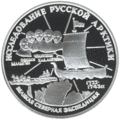
Semion Chelyuskin
(c. 1700–1764)
 Tsardom of Russia
Tsardom of Russia
 Russian Empire
Russian Empire
Russian Imperial Navy officer, Arctic explorer
(Malygin, Ovtsyn, Chelyuskin, K.Laptev and D.Laptev on a modern commemorative coin)Chelyuskin participated in the Great Northern Expedition in 1733-43. He traveled in the groups led by Vasily Pronchischev and Khariton Laptev. In 1741 he led an own voyage from the Khatanga River to the Pyasina River by land. He explored and described the western coastline of Taimyr Peninsula and the mouths of Pyasina and Yenisei Rivers. In 1741-42, he traveled from Turukhansk to the mouth of the Khatanga and described the northern coastline of Taimyr from the Cape Faddey in the east to the mouth of the Taimyra River in the west. Chelyuskin discovered the northern extremity of Asia, Cape Chelyuskin.[25]
Cape Chelyuskin (the northernmost cape of Eurasia), Chelyuskin Peninsula (northern tip of Taymyr), Chelyuskin Island near Taymyr, famous Soviet Chelyuskin steamship and some streets and settlements have been named after Chelyuskin.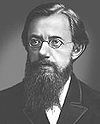
Ivan Chersky
(1845–1892)
 Russian Empire
Russian Empire
(Belorussian and Polish descent)
paleontologist, geologist, geographer, explorer of SiberiaExiled to Transbaikalia for participation in the January Uprising and pardoned only in 1883, Chersky became a self-taught scientist in Siberia. He traveled to Sayan Mountains, Irkut River Valley and Lower Tunguska. During four expeditions in 1877-81 Chersky explored Selenga river. He explained the origin of Lake Baikal, made the first geological map of its coast and described the geological structure of East Siberia. He analysed the tectonics of Inner Asia and pioneered the geomorphological evolution theory. He collected over 2,500 of ancient bones. In 1892 he explored Kolyma, Yana and Indigirka Rivers and died from illness there.[26]
Chersky Mountain Range, Chersky (settlement) in Yakutia, another mountain range in Chita Oblast, Chersky Mountain (highest peak of the Baikal Range), a pass and a peak in the Chamar-Daban, Chersky Stone (a peak in near Listvyanka, Irkutsk Oblast), a valley and a plateau in the Sayan Mountains, a waterfall near Baikal, an inactive volcano, a site near Irkutsk with ancient human remains and a number of species have been named after Chersky.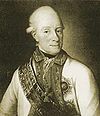
Vasili Chichagov
(1726–1809)
 Russian Empire
Russian Empire
Russian Imperial Navy officer, Admiral, Arctic explorerIn 1764-66 Chichagov led two expeditions to find the Northeast Passage between the Atlantic and the Pacific along the northern coast of Siberia, a project of Mikhail Lomonosov. Although he sailed past Svalbard, reached 80°26'N in 1765 and 80°30'N in 1766, and made valuable research, both expeditions failed to find the route. Later he distinguished himself as victorious Commander-in-chief of the Baltic Fleet in the Russo-Swedish War (1788–1790).[27]
Islands near Novaya Zemlya, Chichagof Island in the Alexander Archipelago near Alaska, a bay and a cape of Nuka Hiva in French Polynesia, and a mountain at Svalbard are named after Chichagov.
Pyotr Chikhachyov
(1808–1890)
 Russian Empire
Russian Empire
naturalist, geologist, explorer of Central Asia and Asia MinorIn 1839-41 Chikhachyov researched geology of Italy. In 1842 he led an expedition to the unknown territories of the Altai and Sayan Mountains. He discovered Kuznetsk Coal Basin, reached the sources of the rivers Abakan, Chu and Chulyshman, and entered Tuva. In 1845 he published works on geology of Altai and Xinjiang. In 1848-63 he led eight expeditions in Asia Minor, Armenia, Kurdistan and East Thrace. In 1853-69 he conducted a major study of Asia Minor, while being the attaché of the Russian embassy in Constantinople. In 1878, at the age of 71, he visited Algeria and Tunis. He published many works in geography, natural history and politics of the Eastern Question.[28]
A mountain range in Altai is named after Chikhachyov. Mountains of Central Asia
Mountains of Central Asia

Artur Chilingarov
(born 1939)
 Soviet Union
Soviet Union
 Russian Federation
Russian Federation
Arctic, Antarctic and deep-sea explorer, Hero of the Soviet Union, Hero of the Russian Federation, politicianIn 1969 Chilingarov became the head of the research station “North Pole-19” and in 1971 the head of Bellingshausen Station during the 17-th Soviet Antarctic Expedition. In 1985 he successfully led the mission to rescue the research vessel Mikhail Somov, which had been ice-blocked in the Southern Ocean. During the Russian Arktika 2007 expedition, Chilingarov, accompanied by other explorers from different countries, descended to the seabed 13,980 feet below the North Pole in order to plant there the Russian flag and gather the specimens of the bottom ground, using MIR submersibles. In 2008 he took part in the expedition which on MIRs to descend one mile to the bottom of Lake Baikal.[29] 
Aleksei Chirikov
(1703–1748)
 Tsardom of Russia
Tsardom of Russia
 Russian Empire
Russian Empire
Russian Imperial Navy officer, captain, explorer of the Russian Far East and AlaskaIn 1725-30 and in 1733-43, Chirikov was Vitus Bering's deputy during the 1st and the 2nd Kamchatka expeditions. On July 15, 1741 Chirikov, the captain of Sv. Pavel, became the first European to land on the northwestern coast of North America near Alexander Archipelago. Thereafter he discovered some of the Aleutian Islands. In 1742 Chirikov specified the location of the Attu Island during the search for the lost Bering's ship. In 1746 Chirikov took part in creating the final map of the Russian discoveries in the northern Pacific Ocean.[30]
Capes of the Kyūshū and Attu islands, capes in Anadyr Bay and Tauyskaya Bay, and an underwater mountain in the Pacific bear Chirikov's name.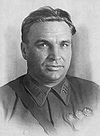
Valery Chkalov
(1904–1938)
 Russian Empire
Russian Empire
 Soviet Union
Soviet Union
aircraft test pilot, Hero of the Soviet UnionChkalov developed several new figures of aerobatics. He was involved in a number of Soviet ultralong flights. In 1936 Chkalov, Georgiy Baidukov and A.V.Belyakov on ANT-25 flew 9,374 km from Moscow through the North Pole to follow-up Chkalov Island in Okhotsk Sea, which took 56 h 20 min. In 1937, also on ANT-25, the same crew flew 8,504 km from Moscow through the North Pole to Vancouver, Washington, which was the first transpolar flight between Europe and North America on airplane, rather than on dirigible.[31]
Chkalovsk city, Chkalov Island in the Okhotsk Sea and a number of streets and metro stations are named after Chkalov.D
Contents: Top · 0–9 A B C D E F G H I J K L M N O P Q R S T U V W X Y Z
Portrait Person Achievements Image 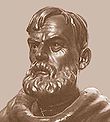
Semyon Dezhnyov
(c. 1605–1672)
 Tsardom of Russia
Tsardom of Russia
Siberian Cossack leader, explorer of Siberia and the Russian Far EastIn 1638 Dezhnyov came to Yakutsk and then to the Indigirka River where he served under Mikhail Stadukhin. Together they discovered Kolyma River and founded Srednekolymsk there in 1643. Fedot Popov organized the further expedition eastward, and Dezhnyov became a captain of one koch. In 1648 they sailed from Srednekolymsk down to the Arctic and after some time they rounded a 'great rocky projection', thus becoming the first to pass through the Bering Strait and to discover Chukotka and Bering Sea. All their kochs and most of their men (including Popov himself) were lost in storms and clashes with the natives. A small group led by Dezhnyov reached the mouth of Anadyr River and sailed up it in 1649, having built new boats of the wreckage. They founded Anadyrsk and were stranded there, until Stadukhin found them, coming from Kolyma by land.[32]
A mountain ridge in Chukotka, a bay of the Bering Sea, a settlement on Amur River, and Cape Dezhnyov (the easternmost cape of Eurasia) are named after Dezhnyov.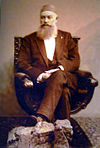
Vasily Dokuchaev
(1846–1903)
 Russian Empire
Russian Empire
geographer, geologist, pedologist, explorer of European RussiaDokuchaev led numerous expeditions to study soils and geology of European Russia. In 1871-77 he traveled through Finland and Northern and Central Russia, and in 1877-81 through Chernozem Region. In 1897-1900 he traveled to the Caucasus, Bessarabia and Central Asia. As a result of his long research of Russian soils, he founded the modern soil science, developed the conception of biomes and proposed ways to improve soil productivity.[2]
Dokuchaevsk town and a village in Ukraine, a number of streets and soil research institutions have been named after Dokuchaev. Global soil regions
Global soil regions
E
Contents: Top · 0–9 A B C D E F G H I J K L M N O P Q R S T U V W X Y Z
Portrait Person Achievements Image Adolf Etolin
(1799–1876)
 Sweden
Sweden
 Russian Empire
Russian Empire
(born in Finland)
Russian Imperial Navy officer, explorer of Alaska, governor of Russian AmericaEtolin sailed to Alaska with Vasily Golovnin on Kamchatka and entered the service of the Russian-American Company. He was part of a group that surveyed the Aleutian Islands in 1822-24. In 1833 he explored the Gulf of Alaska. Etolin was the governor of Russian America in 1840-45, and continued to explore Alaska and Bering Sea.[33]
Etolin Island, Etolin Strait, a cape and a bay at Nunivak Island, a mountain in Alaska and a cape on Urup Island are named after Etolin. Location of Aleutian Islands
Location of Aleutian Islands
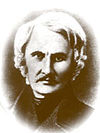
Eduard Eversmann
(1794–1860)
 Holy Roman Empire
Holy Roman Empire
 Russian Empire
Russian Empire
naturalist, explorer of Southern Urals and Central AsiaIn 1817 Eversmann came to Russia and started his travels in the southern Urals to collect specimens. In 1820 he traveled to Bukhara disguised as a merchant and in 1825 traveled with a military expedition to Khiva. In 1828 he became a professor of zoology and botany at the university of Kazan. He wrote numerous publications and pioneered the research of the flora and fauna of the southeast steppes of Russia between Volga and Urals.[34]
A number of birds, such as Eversmann's Redstart, butterflies, such as Eversmann's Parnassian, and moths, such as Eversmann's Rustic are named after Eversmann.F
Contents: Top · 0–9 A B C D E F G H I J K L M N O P Q R S T U V W X Y Z
Portrait Person Achievements Image 
Alexei Fedchenko
(1844–1873)
 Russian Empire
Russian Empire
naturalist, explorer of Central AsiaIn 1868 Fedchenko traveled through Turkestan, including Samarkand, Panjkent and the upper Zarafshan River valley. In 1870 he explored the Fan Mountains south of the Zarafshan. In 1871 he reached the Alay Valley at Daroot-Korgan and explored the northern Pamir Mountains but was unable to penetrate southward. He perished on Mont Blanc while engaged in an exploring tour in France.[18][35]
Fedchenko Glacier in the Pamir Mountains and the asteroid 3195 Fedchenko are named after Fedchenko.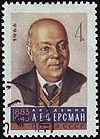
Alexander Fersman
(1883–1945)
 Russian Empire
Russian Empire
 Soviet Union
Soviet Union
geologist, geochemist, explorer of European RussiaFersman founded geochemistry, the science about chemical composition of the Earth. He led numerous expeditions in Crimea, Kola Peninsula and the Urals. He discovered copper and nickel in Monchegorsk, apatite reserves in Khibiny and sulfur in Central Asia.[36]
A pass and a mountain in Murmansk Oblast, a settlement in Crimea, the Fersman Mineralogical Museum in the Urals, the minerals fersmite and fersmanite, a crater on the Moon, and a number of streets are named after Fersman.Ivan Fyodorov
(?–1733)
 Tsardom of Russia
Tsardom of Russia
 Russian Empire
Russian Empire
Russian Imperial Navy officer, navigator, explorer of the Russian Far East and AlaskaFyodorov, a navigator, took part in the 1st Kamchatka expedition of Vitus Bering in 1725-30. In 1732 Fyodorov and geodesist Mikhail Gvozdev aboard Sviatoi Gavriil (Bering's ship) sailed to Cape Dezhnyov, the easternmost point of Asia. From there they sailed east and soon discovered Alaska mainland near the Cape Prince of Wales, the westernmost point of North America. They charted the north-western coast of Alaska. By doing this, Fyodorov and Gvozdev completed the discovery of the Bering Strait, once started by Semyon Dezhnyov and Fedot Alekseyev Popov and continued by Bering. Their expedition also discovered three previously unknown islands.[37] 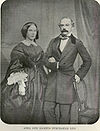
Johan Hampus Furuhjelm
(1821–1909)
 Russian Empire
Russian Empire
(born in Finland, Swedish descent)
Russian Imperial Navy officer, Vice-Admiral, Governor of the Russian Far East, Taganrog and Russian America, explorer of Alaska
(on photo with his wife Anna)In 1850 Furuhjelm became a commander of Novoarkhangelsk port (now Sitka, Alaska) and in 1854 of Ayan port. In 1858-64 he was the Governor of Russian America. He improved relations with natives, once using the Columbus-like trick with an eclipse of the moon to impress the Indians. In 1865-72 Furuhjelm served as military governor of Primorsky Krai and chief of Russian seaports on Pacific, where he contributed a lot to development and exploration of the whole region.[38]
Mount Furuhelm in Alexander Archipelago, Furugelm Island in the Sea of Japan, Furuhelm Street in Sitka (Alaska) were named after Ivan Furuhjelm. Furugelm point and Furugelm island near Sakhalin in the Sea of Japan were named for Carl Furuhjelm, brother of Ivan Furuhjelm.G
Contents: Top · 0–9 A B C D E F G H I J K L M N O P Q R S T U V W X Y Z
Portrait Person Achievements Image 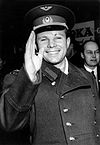
Yury Gagarin
(1934–1968)
 Soviet Union
Soviet Union
Soviet Air Force pilot, cosmonaut, the Hero of the Soviet UnionOn 12 April 1961, Gagarin became the first ever human to travel into space, launching to orbit aboard the Vostok 3KA-3 (Vostok 1).[39]
Gagarin town near the place of Gagarin's birth, Gagarin town in Armenia, Gagarin crater on the far side of the Moon, asteroid 1772 Gagarin, a scientific ship Kosmonaut Yuri Gagarin, a vast number of settlements, streets, squares and other places in the Soviet Union and Russia, along with many other objects ranging from bars and clubs to Gagarin Cup, are named in honor of Yury Gagarin. Cosmonautics Day aka Yuri's Night is a yearly held celebration of Gagarin's flight on 12 April.Yakov Gakkel
(1901–1965)
 Russian Empire
Russian Empire
 Soviet Union
Soviet Union
oceanographer, Arctic explorerGakkel was a director of the geography department of the Arctic and Antarctic Research Institute. He participated in numerous Arctic expeditions, including the ones on the icebreakers Sibiryakov in 1932 and Chelyuskin in 1934. He was the first to create a bathymetric map of the Arctic basin.[3]
In 1966, the Gakkel Ridge, a mid-oceanic ridge in the Arctic Ocean, was named after Gakkel.Matvei Gedenschtrom
(1780–1845)
 Russian Empire
Russian Empire
public servant, writer, explorer of Arctic and SiberiaGedenschtrom was sent to serve in Siberia for connection with a smuggling affair at Tallinn customs. In 1809-10 together with Yakov Sannikov he led the cartographic expedition to the Arctic shores of Yakutia. They explored and named the New Siberian Islands (earlier discovered by Yakov Permyakov). This expedition established a theory about the existence of the legendary Sannikov Land somewhere northwest of the Kotelny Island. Gedenschtrom discovered the presence of Siberian polynya (patches of open water at the edge of the drifting ice and continental fast ice). He charted the coastline between the Yana and Kolyma Rivers. He made numerous trips across Yakutia and the areas east of Lake Baikal.[2] 
Johann Gottlieb Georgi
(1729–1802)
 Prussia
Prussia
 Russian Empire
Russian Empire
geographer, naturalist, ethnographer, physician, chemist, explorer of European Russia and SiberiaGeorgi accompanied both Johann Peter Falck and Peter Simon Pallas on their respective journeys through European Russia and Siberia. In 1772 he mapped Lake Baikal and was the first to describe omul fish, as well as other fauna and flora of Baikal region. He amassed a large collection of minerals and in 1776-80 published the first comprehensive work on ethnography of indigenous peoples of Russia.[40]
Georgia flower was named after Georgi. Omul in an aquarium in the Baikal-Museum in Listvyanka
Omul in an aquarium in the Baikal-Museum in Listvyanka

Johann Georg Gmelin
(1709–1755)
 Holy Roman Empire
Holy Roman Empire
 Russian Empire
Russian Empire
naturalist, botanist, geographer, explorer of European Russia and SiberiaIn 1733-43 Gmelin participated in the Great Northern Expedition and made a number of journeys through Siberia, covering more than 34,000 km in the total. He discovered that the Caspian Sea lies below the ocean level. He published two major works about his travels in Russia and the flora of Siberia, and described more than 500 previously unknown plants.[41]
The settlement of Gmelinka, Gmelina plant genus, Larix gmelinii tree and other plants are named after Gmelin.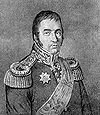
Vasily Golovnin
(1776–1831)
 Russian Empire
Russian Empire
Russian Imperial Navy officer, Vice Admiral, circumnavigator, explorer of the Far EastHe made two circumnavigations on the sloop Diana (1807–09) and the frigate Kamchatka (1817–19). In 1811 Golovnin described and mapped part of the Kuril Islands. At that time he was taken prisoner for two years by the Japanese. He described in books his years in captivity, life in Japan, and his voyages around the world. Later he was athe General Quartermaster of Russian Navy and supervised the building of the first Russian steamships. He tutored Fyodor Litke, Ferdinand von Wrangel and other famous seafarers.[42]
The village of Golovin, Alaska, a cape in the west of North America, a bay in the Bering Sea, a strait between two of the Kuril Islands, a volcano on Kunashir Island, mountains on Novaya Zemlya and on Franz Josef Land are named after Golovnin. He is a character in Patrick O'Brian's The Mauritius Command. Golovnin's circumnavigations
Golovnin's circumnavigations
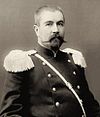
Bronislav Gromchevsky
(1855–1926)
 Russian Empire
Russian Empire
 Soviet Union
Soviet Union
(Polish descent)
Imperial Russian Army officer, explorer of Central AsiaGromchevsky participated in the Russian conquest of Central Asia and then led reconnaissance expeditions in the surrounding regions. In 1885-86 he explored Kashgar and Tian Shan. In 1888-89 he explored the Pamirs, Kafiristan, Kashmir and northwestern Tibet and went as far as into the British India. He is regarded as the Russian counterpart to the British military-explorer Francis Younghusband. The two Great Game rivals famously met in 1889 when they were exploring the Hunza Valley for their respective governments. In 1900 Gromchevsky explored North Eastern China.[18][43] 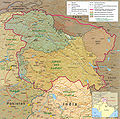 Kashmir region
Kashmir region
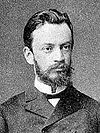
Grigory Grumm-Grzhimaylo
(1860–1936)
 Russian Empire
Russian Empire
 Soviet Union
Soviet Union
zoologist, entomologist, ethnographer, geographer, explorer of Central AsiaIn 1884 Grumm-Grzhimaylo started his first Pamir expedition on which he explored the Alai Mountains and reached as far as Lake Karakul. In 1885-87 he extensively traveled through Central Asia, reaching the Great Silk Route, Lake Chatyr-Kul and Kashgar. In this expedition he collected tens of thousands of insects and other specimens. In 1889-90 he discovered the Ayding Lake, the second lowest land point on Earth, at 130 m below the sea level. He obtained two Przewalski's Horses and more than 1000 bird specimens during 8600 km long travel. In 1903 he explored Mongolia and Tuva and later traveled in the Far East.[3][18]
A pass in Sikhote-Alin Mountains, a glacier he discovered in the Pamirs and a glacier in Bogdo Ula are named after Grumm-Grzhimaylo.Mikhail Gvozdev
(1700-04 – after 1759)
 Tsardom of Russia
Tsardom of Russia
 Russian Empire
Russian Empire
military geodesist, explorer of the Far East, co-discoverer of AlaskaGvozdev took part in the 1st Kamchatka expedition of Vitus Bering. In 1732 together with Ivan Fedorov aboard Sviatoi Gavriil (Bering's ship) they reached Dezhnev Cape (the easternmost point of Asia), sailed east and soon discovered Alaska mainland near the Cape Prince of Wales (the westernmost point of North America). They charted the part of Alaska coast and discovered three new islands. Thus they completed the discovery of the Bering Strait, once started by Semyon Dezhnyov and Fedot Alekseyev Popov and continued by Bering. Subsequently in 1741-42 Gvozdev participated in the expedition led by Alexey Shelting and mapped most of the western and southern shores of the Okhotsk Sea, and the eastern shore of Sakhalin.[44][45]
A cape on Sakhalin island is named after Gvozdev.H
Contents: Top · 0–9 A B C D E F G H I J K L M N O P Q R S T U V W X Y Z
Portrait Person Achievements Image 
Ludwig von Hagemeister
(1780–1833)
 Russian Empire
Russian Empire
(born in Latvia, Baltic German descent)
Russian Imperial Navy captain, governor of Russian America, circumnavigator, explorer of the Pacific and AlaskaAfter taking part in Napoleonic Wars, at which point his abilities were praised by admiral Nelson, in 1806-07 Hagemeister journeyed to Russian America on his ship Neva. In 1808-09, he explored the shores of Alaska and waters of the North Pacific. In 1812-15 he supervised the building of the first tall ships to sail on Lake Baikal. In 1816-19 he was in charge of Kutuzov, on which he made his first full circumnavigation of the globe, with a stop in Alaska, where he was a governor of Russian America in 1818-19. In 1828-29, Hagemeister made his second circumnavigation aboard Krotky. Among other islands he surveyed the Menshikov Atoll (Kwajalein) in the Marshall Islands group.[46]
Hagemeister Island and a strait in Alaska, a mountain in Alexander Archipelago and an atoll group in the Pacific were named after Hagemeister. Hagemeister's sea voyages
Hagemeister's sea voyages
I
Contents: Top · 0–9 A B C D E F G H I J K L M N O P Q R S T U V W X Y Z
Portrait Person Achievements Image Kurbat Ivanov
(?–1666)
 Tsardom of Russia
Tsardom of Russia
Siberian Cossack voevoda, explorer of East Siberia and the Russian Far EastInitially Kurbat Ivanov was a Yeniseyan Cossack. In 1642, on the basis of explorations made by Ivan Moskvitin, he made the earliest known map of the Russian Far East. In 1643 With a group of Cossacks he sailed up Lena River from Verkholensky ostrog, having decided to check the rumors of large body of water to the south. They crossed Baikal Mountains by foot, descended down the Sarma River and discovered Lake Baikal and visited its Olkhon Island. Ivanov made the first chart and description of Baikal. In 1659-65 Ivanov was the next head of Anadyrsky ostrog after Semyon Dezhnyov. In 1660 he sailed from Anadyr Bay to Cape Dezhnyov. He is credited with creation of the early map of Chukotka and Bering Strait, which was the first to show on paper (very schematically) the yet undiscovered Wrangel Island, both Diomede Islands and Alaska.[47][48] Gerasim Izmailov
(c. 1745 – after 1795)
 Russian Empire
Russian Empire
Russian Imperial Navy officer, explorer of AlaskaIn 1771 Izmailov was caught up in the Benevsky mutiny while serving on Kamchatka. After an attempt to break away from the mutineers he was marooned on Simushir, an uninhabited isle in the Kurils. For a year he lived as Robinson there before being rescued, tried on charges of mutiny and cleared. Starting in 1775 he created the first detailed map of the Aleutian Islands. In 1778 he met with Captain James Cook in Unalaska. In 1783-85 Izmaylov and Grigory Shelikhov founded the first permanent Russian settlement in North America on Kodiak Island. In 1789 Izmaylov became the first to explore and map the Kenai Peninsula. Later he helped Alexander Baranov to fight off the Tlingit natives and saved a lost crew of a Russian ship from Saint Paul Island.[49] J
Contents: Top · 0–9 A B C D E F G H I J K L M N O P Q R S T U V W X Y Z
Portrait Person Achievements Image 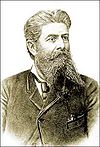
Wilhelm Junker
(1840–1892)
 Russian Empire
Russian Empire
(German descent)
physician, etnographer, explorer of AfricaBorn in a rich family of Moscow banker, Junker journeyed to Iceland, Tunis and Lower Egypt for his own money. Then he carried out a major exploration of Eastern and Equatorial Africa in 1875-86, with Khartoum and then Lado as bases for his expeditions. He researched African peoples, including Azande from Niam-Niam, and collected plant and animal specimens. He explored the Nile-Congo watershed, where he established the identity of the Uele and Ubangi rivers. The Mahdist rising prevented his return to Europe through the Sudan, and in 1884-86 he went south, traveled through Uganda and Tabora, reached Zanzibar and finally returned to St. Petersburg.[18] 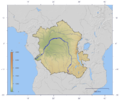 Congo River basin
Congo River basin
K
Contents: Top · 0–9 A B C D E F G H I J K L M N O P Q R S T U V W X Y Z
Portrait Person Achievements Image 
Johann Karl Ehrenfried Kegel
(1784–1863)
 Holy Roman Empire
Holy Roman Empire
 Russian Empire
Russian Empire
agronomist, explorer of Kamchatka1841 Kegel was sent to Kamchatka Peninsula to investigate possibilities of agriculture and mining. In 1841-47 he traveled extensively through Kamchatka, crossed it several times and subsequently wrote the most detailed account of Kamchatka's nature and ethnography at that time.[50]  Avachinsky Volcano in Kamchatka
Avachinsky Volcano in Kamchatka

Yerofey Khabarov
(1603 – after 1671)
 Tsardom of Russia
Tsardom of Russia
Siberian Cossack ataman, explorer of East Siberia and Amur River regionA manager for the merchants Stroganovs, Khabarov went to Siberia and in 1641 founded a settlement and saltworks on the Lena River. In 1649-50 he became the second Russian to explore the Amur river (after Vassili Poyarkov). Through Olyokma, Tungur and Shilka Rivers he reached Amur (Dauria), returned to Yakutsk and then back to Amur with a larger force. This time he was met with armed resistance. He built winter quarters at Albazin, then sailed down Amur and found Achansk, which preceded the present-day Khabarovsk, defeating or evading large armies of Daurian Manchu Chinese and Koreans on his way. There was a mutiny against him, then he mutined himself when a nobleman Dimitry Zinoviev appeared with new reinforcements and demanded full command. Zinoviev was unable to deal with the Manchus, and finally withdrew, leaving Onufriy Stepanov in charge. Khabarov was sent to Moscow, acquitted and returned to Siberia. He charted the Amur in his Draft of the Amur river.[51][52]
The major city of Khabarovsk, a town and a railway station Yerofey Pavlovich on the Trans-Siberian railroad in Amur Oblast bear Khabarov's name. Amur River basin
Amur River basin
Maria Klenova
(1898–1976)
 Russian Empire
Russian Empire
 Soviet Union
Soviet Union
marine geologist, Arctic and Antarctic explorerKlenova was one of the founders of marine geology. She began her career in 1925 aboard the Soviet research vessel Persey in the Barents Sea, visiting Novaya Zemlya, Spitsbergen and Franz Josef Land. In 1933 Klenova made the first complete seabed map of the Barents Sea. Her later work included the research of seabed geology in the Atlantic and the Antarctic, and in the Caspian and White Seas. She was one of the earliest women explorers of Antarctic.[53]
The Klenova Valley in the Arctic and a crater on Venus are named after Klenova. Barents Sea as seen from space
Barents Sea as seen from space

Aleksandr Kolchak
(1874–1920)
 Russian Empire
Russian Empire
Russian Imperial Navy officer, Admiral, Arctic explorerKolchak joined the expedition of Eduard Toll on ship Zarya in 1900 as a hydrologist. He took part in two further Arctic expeditions and explored the shores of Taymyr. For a while was nicknamed "Kolchak-Poliarnyi" ("Kolchak the Polar"). Then he distinguished himself in the Russo-Japanese War and in World War I, and during the Russian Civil War he was one of the main leaders of the White movement. He published a number of important works on Arctic ice.[54]
Kolchak Island, discovered and explored by Kolchak is named after him.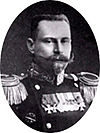
Nikolai Kolomeitsev
(1867–1944)
 Russian Empire
Russian Empire
 France
France
Russian Imperial Navy officer, Arctic explorerAfter several expeditions in the Arctic, Kolomeitsev became a commander of Eduard Toll's Zarya during Russian Polar Expedition in 1900. They aimed to explore the area north of the New Siberian Islands and to find the Sannikov Land. There was a disagreement between Kolomeitsev and Toll over the treatment of the crew, and finally Fyodor Matisen was made captain, while Kolomeitsev was sent with Stepan Rastorguyev to organize coal depots and carry the post to the mainland. They made a number of discoveries on the 800 km long sledge trip over Taymyr. Later he became a hero of the Russo-Japanese War.[55]
Kolomeitsev Islands, a bay and a strait in the Kara Sea, a river on Taymyr, a mountain and a Soviet ship have been named after Kolomeitsev.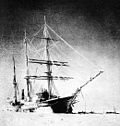 Polar ship Zarya
Polar ship Zarya
Alexander Konrad
(?–1940)
 Russian Empire
Russian Empire
 Soviet Union
Soviet Union
sailor in the Russian Imperial Navy and the Soviet Navy, Arctic explorerKonrad was one of the only two survivors of the ill-fated 1912-14 Brusilov expedition, the other being lieutenant Valerian Albanov. They left ice-bound ship St. Anna and by ski, sledge, and kayak crossed the Kara Sea, reached Franz Josef Land and finally were rescued by Georgy Sedov's Saint Foka. The data about ice drift of St. Anna, provided by Albanov, helped Vladimir Vize to calculate the coordinates of previously unknown Vize Island. In 1939, serving on a Soviet ship, Konrad completed the full passage of the Northern Sea Route, which had been the main goal of St. Anna.[1]
A glacier in Severnaya Zemlya is named after Albanov. Either Albanov or Konrad is a prototype fora hero in the novel The Two Captains by Veniamin Kaverin. St. Anna vessel
St. Anna vessel
Fyodor Konyukhov
(born 1951)
 Soviet Union
Soviet Union
 Russian Federation
Russian Federation
yacht captain, traveler, painter, writerBy the age of 50 Konyukhov has made more than 40 unique trips and climbs expressing his vision of the world in more than 3000 paintings and 9 books. He set a record of crossing the Atlantic on a single row-boat in 46 days. He also crossed 800 km for record 15 days and 22 hours during a Trans-Greenland dog sleigh ride. He was the first Russian to complete the Three Poles Challenge and Explorers Grand Slam. He is the first and so far the only person in the world to have reached the five extreme Poles of the planet: North Pole (3 times), South Pole, Pole of inaccessibility in the Arctic Ocean, Mt. Everest (Alpinists pole) and Cape Horn (Yachtsmen pole). He set a record for the solo yacht circumnavigation of Antarctica in 2008, making it in 102 days.[56][57]  The Seven Summits on an elevation world map
The Seven Summits on an elevation world map
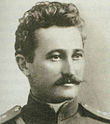
Nikolai Korzhenevskiy
(1879–1958)
 Russian Empire
Russian Empire
 Soviet Union
Soviet Union
Russian Imperial Army officer, geographer, glaciologist, explorer of Central AsiaIn 1903-28 Korzhenevskiy organized eleven expeditions to explore the Pamir Mountains. He discovered a number of glaciers and the highest peaks in the Pamirs, including Peak Korzhenevskaya which he named after his wife Evgeniya. He discovered and called Akademiya Nauk Range (in honor of the Academy of Sciences of the USSR) and made a catalogue of all glaciers in Central Asia, himself having discovered 70 of them.[3]
Three glaciers in different Central Asia mountain ridges and a peak in the Pamirs have been named after Korzhenevskiy. Peak Korzhenevskaya in the Pamirs
Peak Korzhenevskaya in the Pamirs
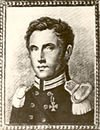
Otto von Kotzebue
(1787–1846)
 Russian Empire
Russian Empire
(born in Estonia, Baltic German descent)
Russian Imperial Navy officer, circumnavigator, explorer of Arctic, Alaska and PacificKotzebue accompanied Ivan Krusenstern in the first Russian circumnavigation in 1803-06. On the brig Rurik he himself led another Russian circumnavigation in 1815-18. Proceeding via Cape Horn, he discovered the Romanzov Islands, Rurik Islands and Krusenstern Islands (today Tikehau) in Pacific, then made for Kamchatka Peninsula and proceeded along the north-west coast of North America to the Chukchi Sea. He discovered and named Kotzebue Sound and Cape Krusenstern. Returning south he discovered the New Year Island in Pacific. In 1823-26 he made another world cruise on the sloop "Enterprise"making several discoveries.[18]
Kotzebue Sound and the city of Kotzebue, Alaska are named after Otto von Kotzebue. Kotzebue's circumnavigations
Kotzebue's circumnavigations

Pyotr Kozlov
(1863–1935)
 Russian Empire
Russian Empire
 Soviet Union
Soviet Union
Russian Imperial Army officer, explorer of Central AsiaKozlov started travelling in the Central Asia with Nikolai Przhevalsky, and after the death of his mentor he continued his work. From 1899 to 1901 he explored the upper reaches of Huang He, Yangtze, and Mekong rivers. Kozlov rivalled Sven Hedin and Aurel Stein as the foremost researcher of Xinjiang at the historical peak of the Great Game. In 1907 he visited the Dalai Lama in Urga. In 1907-09, Kozlov explored the Gobi Desert and discovered remains of the ancient Tangut city of Khara-Khoto. He excavated the site and uncovered no less than 2,000 books in Tangut language. In 1923-26 he explored Mongolia and Tibet and discovered an unprecedented number of Xiongnu royal burials at Noin-Ula.[58] 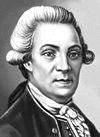
Stepan Krasheninnikov
(1711–1755)
 Tsardom of Russia
Tsardom of Russia
 Russian Empire
Russian Empire
geographer and explorer of Siberia and KamchatkaKrashennikov was a classmate of Mikhail Lomonosov. He embarked upon a major Second Kamchatka Expedition, organised by Vitus Bering. Krashennikov traveled in Siberia in 1733-36 and on Kamchatka Peninsula in 1737-41. He gave the first full description of Kamchatka in his book An Account of the Land of Kamchatka, with detailed report of the plants and animals of the region, and also the language and culture of the indigenous Itelmen and Koryak peoples.[59]
The Krasheninnikov Volcano on Kamchatka and more than 20 species are named after Krasheninnikov.Pyotr Krenitsyn
(1728–1770)
 Russian Empire
Russian Empire
Russian Imperial Navy officer, explorer of Alaska and PacificIn 1766-70 Krenitsyn led the "secret" expedition to the North Pacific together with Mikhail Levashov, as ordered by Catherine II. They explored the Aleutian Islands and part of Alaska shore, discovering good haven in Unalaska and many features of Alaskan coast. Krenitsyn died drowning in Kamchatka River. On the basis of his explorations the first general map of the Aleutian Islands was created.[2]
The Krenitzin Islands in Aleutian chain, a strait between Onekotan and Kharimkotan islands in the Kurils, the highest volcano on Onekotan, a cape and a volcano on Kharimkotan and a cape in Bristol Bay of the Bering Sea are named after Krenitsyn.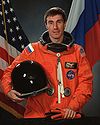
Sergei Krikalyov
(born 1958)
 Soviet Union
Soviet Union
 Russian Federation
Russian Federation
cosmonaut and mechanical engineer, Hero of the Soviet Union, Hero of the Russian FederationKrikalyov has spent in space a record 803 days and 9 hours and 39 minutes during his six spaceflights. As a Soviet cosmonaut he traveled in space and back aboard Soyuz TM-7 in 1988 and then launched upon Soyuz TM-12 in 1991, both times working on the Soviet Space Station Mir. "The last Citizen of the USSR", Krikalev landed back on Earth aboard Soyuz TM-13 in 1992 to turn into a Russian cosmonaut. He became the first Russian to travel on the American Space Shuttle during STS-60 mission to Mir in 1994, and then he made another Shuttle flight STS-88, which was the first Shuttle mission to International Space Station. He again traveled to ISS on Soyuz TM-31 in 2000 and returned back on STS-102 in 2001. And yet again he traveled to ISS and back on Soyuz TMA-6 in 2005.[60] 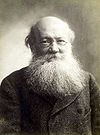
Pyotr Kropotkin
(1842–1921)
 Russian Empire
Russian Empire
Russian Imperial Army officer, geographer, zoologist, anarchist, explorer of Siberia, the Far East and the Northern EuropeWhile serving in Siberia, in 1864 Kropotkin led survey expedition crossing North Manchuria from Transbaikalia to the Amur River. Subsequently he took part in the expedition which proceeded up the Sungari River into central Manchuria, yielding valuable geographical results. In 1871 he explored the glacial deposits of Finland and Sweden. He published several important works on geography of Asia. Kropotkin was also one of the most prominent Russian anarchists and revolutionaries.[61]
The town of Kropotkin, Krasnodar Krai, a settlement in Irkutsk Oblast, an inactive volcano in Buryatia, Kropotkinskaya station of Moscow metro and many streets in Soviet and Russian cities have been named after Kropotkin. Manchuria in 1892
Manchuria in 1892
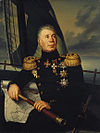
Adam Johann von Krusenstern
(1770–1846)
 Russian Empire
Russian Empire
(born in Estonia, Baltic German descent)
Russian Imperial Navy officer, circumnavigator, explorer of PacificIn 1803-06, under the patronage of Tsar Alexander I and Baron Nikolai Rezanov, Krusenstern led the first Russian circumnavigation of the world aboard Nadezhda together with Yuri Lisianski on Neva. The purpose of the expedition was to establish trade with China and Japan, and examine California for a possible colony. They sailed from Kronstadt, rounded Cape Horn, and reached the northern Pacific. Krusenstern's account of his journey was published in Russia and many European countries. He made an atlas of the Pacific, receiving an honorary membership in the Russian Academy of Sciences for that.[3]
The Russian training tall ship Kruzenshtern, crater Krusenstern on the Moon, Krusenstern Island in the Marshall Islands, Krusenstern Island in the Tuamotus, Krusenstern Island in the Bering Strait, as well as Krusenstern Islands in the Kara Sea have been named after Krusenstern. Modern ship Kruzenshtern repeating the journey of Nadezhda on its 200th anniversary
Modern ship Kruzenshtern repeating the journey of Nadezhda on its 200th anniversary
Alexander Kuchin
(1888–1913?)
 Russian Empire
Russian Empire
Russian Imperial Navy officer, oceanographer, Arctic and Antarctic explorerKuchin's life was bound with Norway: he started as a seaman on a Norwegian ship, created a Small Russian-Norwegian dictionary, studied oceanography from Bjorn Helland-Hansen, participated in Amundsen’s expedition to the South Pole on the Fram, and married Aslaug Poulson, a Norwegian. In 1912-13 he took part in Vladimir Rusanov’s expedition to Svalbard as the captain of their ship Gerkules. After the successful research of the coal reserves on Svalbard, without consultation with the Russian authorities they made an incredibly rash attempt to pass via the Northern Sea Route, and were lost in the Kara Sea. Relics of Gerkules were found near Kolosovykh Islands.[62]
Two islets off Salisbury Island in Franz Josef Land have been named after Kuchin.L
Contents: Top · 0–9 A B C D E F G H I J K L M N O P Q R S T U V W X Y Z
Portrait Person Achievements Image 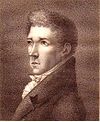
Grigory Langsdorff
(1774–1852)
 Holy Roman Empire
Holy Roman Empire
 Russian Empire
Russian Empire
physician, naturalist, consul general of Russia in Rio de Janeiro, explorer of the Aleutian Islands and BrazilLangsdorff participated as naturalist and physician in the first Russian circumnavigation commanded by Ivan Kruzenshtern in 1803-05. Independently, he explored the Aleutians, Kodiak and Sitka in 1805-07. In 1813 he was nominated consul general of Russia in Rio de Janeiro, Brazil. There he explored the flora, fauna and geography of the province of Minas Gerais with French naturalist Augustin Saint-Hilaire in 1813-20. In 1821-22 he led an exploratory and scientific expedition from São Paulo to Pará in the Amazon via a fluvial route, accompanied by an international team of scientists. In 1826-29 he led a 6000 km long expedition from Porto Feliz to Amazon River and back. As a consequence of the tropical fever, he became insane and went to Europe for healing. Still he and his companions were able to emass huge scientific collections now deposited in Kunstkamera, St. Petersburg, including much valuable material on Brazilian nature and ethnography.[63] 
Dmitry Laptev
(1701–1771)
 Tsardom of Russia
Tsardom of Russia
 Russian Empire
Russian Empire
Russian Imperial Navy officer, Vice Admiral, explorer of Siberia and Arctic
(Malygin, Ovtsyn, Chelyuskin, K.Laptev and D.Laptev on a modern commemorative coin)A cousine of Khariton Laptev, Dmitry Laptev led one of the parties of the Great Northern Expedition in 1739-42. He described the sea coastline from the mouth of the Lena River to the Cape Bolshoy Baranov east of the mouth of Kolyma, the basin and the mouth of the Anadyr River, and land route from the Anadyr fortress to the Penzhin Bay. In 1741-42, Laptev surveyed the rivers of Bolshoy Anyuy and Anadyr. Later he continued his service in the Baltic Fleet and became Vice Admiral.[64]
A cape in the delta of the Lena River and a strait between the Bolshoy Lyakhovsky Island and Siberian mainland bear Dmitry Laptev's name. The Laptev Sea is named after Dmitry Laptev and Khariton Laptev.
Khariton Laptev
(1700–1763)
 Tsardom of Russia
Tsardom of Russia
 Russian Empire
Russian Empire
Russian Imperial Navy officer, explorer of Siberia and Arctic
(Malygin, Ovtsyn, Chelyuskin, K.Laptev and D.Laptev on a modern commemorative coin)A cousine of Dmitry Laptev, Khariton Laptev led one of the parties of the Great Northern Expedition in 1739-42. Together with Semion Chelyuskin, N. Chekin, and G. Medvedev, Laptev described the Taimyr Peninsula from the mouth of the Khatanga River to the mouth of the Pyasina river and discovered several islands. He participated in the creation of the "General Map of the Siberian and Kamchatka Coast", and then continued his service in the Baltic Fleet.[64]
The sea coastline of the Taimyr Peninsula, a cape on the Chelyuskin Peninsula and other landmarks bear Khariton Laptev's name. The Laptev Sea is named after Dmitry Laptev and Khariton Laptev.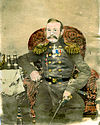
Mikhail Lavrov
(1799–1882)
 Russian Empire
Russian Empire
Russian Imperial Navy officer, Rear Admiral, Arctic explorerLavrov participated in the voyage of the cargo ship Mezen from Kronstadt to Arkhangelsk and back in 1819-20. In 1821-24 he participated in the expedition of Fyodor Litke to Novaya Zemlya, making description of its shores and the coastline near Murmansk. In 1825-27, he sailed around the world on board of sloop Krotkiy led by Ferdinand Wrangel, visiting Kamchatka and Russian America. Later he became Rear Admiral for his feats of arms.[2]
A cape to in the Arctic and an island in Severnaya Zemlya were named after Lavrov.Adam Laxman
(1766–1806?)
 Russian Empire
Russian Empire
(Finland-Swedish descent)
Russian Imperial Army officer, diplomat, explorer of JapanSon of Kirill Laxman, Adam Laxman was sent to Japan on a diplomatic mission in 1791-92, with the aim to return Daikokuya Kōdayū and another Japanese castaway in exchange for trade concessions from Tokugawa shogunate. He made valuable observations, but returned to Russia essentially empty-handed, though he possibly obtained the first official Japanese documents granting very limited permission to trade, to a nation other than China or the Netherlands.[65] Kirill Laxman
(1737–1796)
 Sweden
Sweden
 Russian Empire
Russian Empire
(Finland-Swedish origin)
clergyman, naturalist, explorer of Northern Europe and SiberiaKirill Laxman became a priest first in St. Petersburg and then in Siberian town of Barnaul. In 1764-68 he explored Siberia, reaching Irkutsk, Baikal, Kiakhta and the border with China and researching the Siberian flora and fauna. In 1782 he founded the oldest museum in Siberia in Irkutsk, where he settled earlier and was a business partner of Alexander Baranov (the future governor of Russian America). Laxman was engaged in attempts to establish relationships between Russia and Japan. He brought Daikokuya Kōdayū, a Japanese castaway, to the court of empress Catherine II, and after that his son Adam Laxman was sent with Kōdayū to Japan.[3]
A number of plant species have been named after Laxman.
Mikhail Lazarev
(1788–1851)
 Russian Empire
Russian Empire
Russian Imperial Navy officer, Admiral, circumnavigator, Antarctic and Pacific explorerLazarev thrice circumnavigated the globe. He led 1813-16 circumnavigation aboard the vessel Suvorov and discovered Suvorov Atoll. He commanded Mirny, the second ship in the Russian circumnavigation of 1819-21 under the leadership of Fabian Gottlieb von Bellingshausen aboard Vostok – this expedition was the first to discover the contenent of Antarctica on January 28, 1820 (New Style). They also discovered and named Peter I Island, Zavodovski, Leskov and Visokoi Islands, Antarctic peninsula mainland and Alexander Island (Alexander Coast), and made some discoveries in the tropical waters of the Pacific. In 1822-25 Lazarev sailed around the globe for the third time on his frigate Kreyser. Lazarev was a hero of the Battle of Navarino, the commander of the Russian Black Sea Fleet for 20 years and the tutor of famous Admirals and war heroes Pavel Nakhimov, Vladimir Kornilov and Vladimir Istomin.[66]
Lazarev Mountains, Lazarev and Novolazarevskaya Stations in Antarctic, Lazarev Atoll in the Pacific Russian Islands, capes in the Amur Liman and on the Unimak Island, an island in the Aral Sea, a bay and a port in the Sea of Japan, Lazarevskoye settlement near Sochi and other locations, a number of streets and vessels, and minor planet 3660 Lazarev are named in honor of Lazarev. Lazarev's world cruise on Suvorov
Lazarev's world cruise on Suvorov
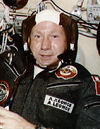
Alexei Leonov
(born 1934)
 Soviet Union
Soviet Union
 Russian Federation
Russian Federation
cosmonaut and Soviet Air Force General, twice the Hero of the Soviet Union, painter, writerOn March 18, 1965, connected to the spacecraft Voskhod 2 by a 5.35 meter tether, Leonov became the first person to make a spacewalk, or extra-vehicular activity. He was in the open space for 12 min 9 sec. At the end of the spacewalk, Leonov's spacesuit had inflated in the vacuum to the point where he could not reenter the airlock. He opened a valve to allow some of the suit's pressure to bleed off, and was barely able to get back inside the capsule, where his companion Pavel Belyayev assisted him. Subsequently Leonov made a second spaceflight on Soyuz 19 spacecraft, a part of Apollo–Soyuz Test Project in 1975. Thus Leonov participated in the first joint flight of the U.S. and Soviet space programs. He published several books and albums of paintings, some of which he created in space.[67]
Arthur C. Clarke's book 2010: Odyssey Two was dedicated to Leonov and Andrei Sakharov; the fictional spaceship Cosmonaut Alexei Leonov in the book was named after him.Mikhail Levashov
(c. 1738–1774-76)
 Russian Empire
Russian Empire
Russian Imperial Navy officer, explorer of Alaska and PacificIn 1766-70 Levashov was second-in-command in the "secret" expedition to the North Pacific led by Pyotr Krenitsyn, as ordered by Catherine II. They explored the Aleutian Islands and part of Alaska shore, discovering good haven in Unalaska and many features of Alaskan coast. Levashov also explored and described the Commander Islands. On the basis of their explorations the first general map of the Aleutian Islands was created.[68]
Port Levashef (the harbor in Unalaska), one of the straits between Kuril Islands, a cape and a volcano on Paramushir Island, and a cape in the west of Kamchatka have been named after Levashov. Kamchatka and the Commander Islands
Kamchatka and the Commander Islands
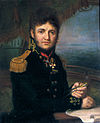
Yuri Lisyansky
(1773–1837)
 Russian Empire
Russian Empire
Russian Imperial Navy officer, circumnavigator, explorer of the PacificIn 1803-06 Lisyansky aboard Neva together with Ivan Krusenstern on Nadezhda led the first Russian circumnavigation of the world. The purpose of the expedition was to establish trade with China and Japan and examine California for a possible colony. They sailed from Kronstadt, rounded Cape Horn, and reached the northern Pacific. The ships split near Hawaii and Lisyanski headed to Russian Alaska, where Neva became essential in defeating the Tlingit in the Battle of Sitka. Lisyansky was the first to describe the Hawaiian monk seal on the island which now bears his name. He met Krusenstern again in Macau, but they soon separated. Eventually, Lisyansky was the first to return to Kronstadt.[69]
Lisianski Island in the Northwestern Hawaiian Islands, a peninsula of the Baranof Island near Alaska, a bay, a strait, a river, a cape in North America, an undersea mountain in Okhotsk Sea and a peninsula there have been named after Lisyansky.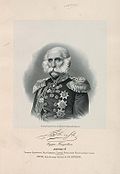
Fyodor Litke
(1797–1882)
 Russian Empire
Russian Empire
Russian Imperial Navy officer, Admiral, circumnavigator, Arctic explorerLitke took part in Vasily Golovnin's world cruise on the ship Kamchatka in 1817-19. In 1821-24, Litke explored the coastline of Novaya Zemlya, the White Sea, and the eastern Barents Sea. In 1826-29, he led the circumnavigation on the ship Senyavin and accompanied by Mikhail Staniukovich on the sloop Moller. During this voyage they explored the Bering Sea (including Pribilof Islands, St. Matthew Island and the Commander Islands), the Bonin Islands off Japan, and the Carolines, discovering 12 new islands. Litke was a co-fouder and the president of the Russian Geographic Society in 1845-50 and 1857-72. He was the president of the Russian Academy of Sciences in 1864-82, and occupied a number of major military and state offices.[70]
Litke gold medal of the Russian Geographical Society, Cape Lutke, Alaska, Litke Strait between Kamchatka and Karaginsky Island, a cape, a peninsula, a mountain and a bay in Novaya Zemlya, a number of islands in the Franz Josef Land, Baydaratskaya Bay, and Nordenskiöld Archipelago, as well as a Russian icebreaker Feodor Litke have been named after Litke. Litke's circumnavigation on Senyavin
Litke's circumnavigation on Senyavin
Fyodor Luzhin
(?–1727)
 Tsardom of Russia
Tsardom of Russia
 Russian Empire
Russian Empire
cartographer, geodesist, explorer of Siberia and the Russian Far EastIn 1719-1721, together Ivan Yevreinov, Luzhin made the first instrumental mapping of Kamchatka and the first map of the Kuril Islands during the "secret expedition", as ordered by Peter I of Russia. In 1723-24 he made surveys of different parts of East Siberia near Irkutsk. In 1725-27, Luzhin participated in the 1st Kamchatka Expedition led by Vitus Bering.[71]
Luzhin Strait which separates Paramushir and Antsiferov Islands in the Kurils, and a cape in Taui Bay of Okhotsk Sea are named after Luzhin.Ivan Lyakhov
(? – c. 1800)
 Russian Empire
Russian Empire
merchant, Arctic explorerLyakhov, a merchant, investigated the New Siberian Islands in three expeditions on dogsleds in 1770, 1773–74 and 1775. He hoped to find mammoth ivory there as he believed the islands were mainly formed by a substratum of bones and tusks of mammoths. He explored the follow-up Lyakhovsky Islands, crossed the Sannikov Strait and discovered Kotelny Island.[72]
Lyakhovsky Islands group in the south of New Siberian Islands are named after Lyakhov.M
Contents: Top · 0–9 A B C D E F G H I J K L M N O P Q R S T U V W X Y Z
Portrait Person Achievements Image 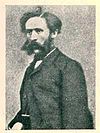
Richard Maack
(1825–1886)
 Russian Empire
Russian Empire
(born in Estonia)
naturalist, geographer, anthropologist, explorer of East Siberia and the Russian Far EastMaack participated in the first expedition to describe the orography, geology and population of the Vilyuy River basin in 1853-55. He explored the Amur River and the Ussuri River in 1855-56 and in 1859 correspondingly. He discovered a number if unknown species and wrote some of the first scientific descriptions of remote Siberia regions.[3][73]
Maackia amurensis, Lonicera maackii, Prunus maackii and other plant species have been named after Maack. Interior of a Mangun house by Maack
Interior of a Mangun house by Maack

Stepan Makarov
(1849–1904)
 Russian Empire
Russian Empire
Russian Imperial Navy officer, vice-Admiral, oceanographer, Arctic explorerMakarov was highly decorated for his service as a captain of the Russian torpedo boat tender Velikiy Knyaz Konstantin in the Russo-Turkish War of 1877–78. On January 16, 1877 he was the first in the world to successfully launch torpedoes (against the Turkish armed ship Intibah). He was one of the developers of Russian Flag semaphore system. Makarov directed two round-the-world oceanographic expeditions on the corvette Vityaz in 1886–89 and in 1894–96. He proposed the idea and oversaw the construction of Yermak, the world's first true icebreaker, which was able to ride over and crash pack ice. He commanded Yermak in two Arctic expeditions in 1899 and in 1901. Promoted to Commander of the Russian Pacific Fleet, Admiral Makarov was killed in action during the Russo-Japanese War of 1904–05 on the battleship Petropavlovsk after his ship struck a mine.[74]
An island in the Tsivolk group of the Nordenskiöld Archipelago, a town on Sakhalin, a number of naval institutions, an embankment in St. Petersburg and other places were named after Stepan Makarov, as well as number of ships called Admiral Makarov. Corvette Vityaz
Corvette Vityaz

Stepan Malygin
(?–1764)
 Tsardom of Russia
Tsardom of Russia
 Russian Empire
Russian Empire
Russian Imperial Navy officer, navigator, captain, cartographer, Arctic explorer
(Malygin, Ovtsyn, Chelyuskin, K.Laptev and D.Laptev on a modern commemorative coin)Malygin was the first one to write a manual on navigation in Russian language in 1733. In the early 1736, he was appointed leader of the western unit of the Great Northern Expedition. In 1736-37, two boats Perviy (First) and Vtoroy (Second) under the command of Malygin and A. Skuratov undertook a voyage from the Dolgiy Island in the Barents Sea to the mouth of the Ob River. During this trip, Malygin for the first time described and mapped the part of the Russian Arctic coastline between the Pechora and Ob Rivers. Later he commanded ships on the Baltic, prepared navigators for the Russian Navy, and was in charge of Riga port during the Seven Years War.[75]
Malygin Strait between Yamal Peninsula and Bely Island, a number of ships (including icebreaker Malygin) and several streets bear Malygin's name.Bely Island and Malygin Strait
Fyodor Matisen
(1872–1921)
 Russian Empire
Russian Empire
Russian Imperial Navy officer, hydrographer, Arctic explorer
Matisen replaced Nikolai Kolomeitsev as a commander of Eduard Toll's Zarya during Russian Polar Expedition in 1900-03. He was the first to make a thorough geographical survey of the Nordenskiöld Archipelago, exploring it on dogsled and discovering and naming 40 of its islands. Subsequently Toll and Matisen led Zarya across the Laptev Sea to the New Siberian Islands. The ship was trapped in fast ice, and Toll and three companions went in search of the elusive Sannikov Land on foot and kayaks, and were lost. When Zarya became able to set sail, Matisen made it towards the Lena river delta.[55]
A strait in the Nordenskiöld Archipelago and a coastal survey ship bear Matisen's name.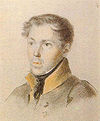
Fyodor Matyushkin
(1799–1872)
 Russian Empire
Russian Empire
Russian Imperial Navy officer, Admiral, circumnavigator, Arctic explorer
Matyushkin studied in Tsarskoselskiy College together with Alexander Pushkin. He participated in Vassili Golovnin's world cruise aboard Kamchatka in 1817-19. In 1820-24 he took part in Ferdinand Wrangel's Arctic expedition to the East Siberian Sea and the Chukchi Sea. They explored and mapped the Medvyezhi Islands. Following this survey, Matyushkin on his own explored a vast tundra area east of the Kolyma river. In 1825-27, he joined Wrangel in his world cruise aboard Krotky. Later he took part in the Russo-Turkish War, 1828-1829 and became Admiral.[2][76]  Kolyma region nature
Kolyma region nature
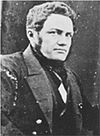
Alexander Middendorff
(1815–1894)
 Russian Empire
Russian Empire
(Baltic German descent)
zoologist, botanist, geographer, explorer of the Northern Europe, Siberia, Arctic, the Russian Far East and Central AsiaIn 1840 Middendorff took part in Karl Baer's expedition to the Kola Peninsula and Lapland. In 1843-45 he pioneered the scientific exploration of the Taimyr Peninsula and discovered Putorana Plateau in the Central Siberia. Then he traveled along the coast of the Sea of Okhotsk and entered the lower Amur River valley. He studied the ethnography of Siberian peoples, the climate, animals and plants of Siberia. He was a founder of the permafrost science and the Vice President of the Russian Geographical Society. He determined the southern border of permafrost and explained the high sinuosity of the northern boundary of taiga zone. In 1870 he accompanied Grand Duke Alexei Alexandrovich to Novaya Zemlya and discovered the North Cape sea current (a part of Norwegian Current). In 1870 he also explored the Baraba steppe, and in 1878 he travelled in Fergana Valley. He was also a prominent hippologist and contributed in the development of agriculture in Russia.[77]
Cape Middendorff in Novaya Zemlya, Middendorff Bay (Taymyr Peninsula), Middendorff's Grasshopper Warbler, Ursus arctos middendorffi (Kodiak Bear) and some other species are named after Middendorff.
Nicholas Miklouho-Maclay
(1846–1888)
 Russian Empire
Russian Empire
(Ukrainian, German and Polish descent)
ethnologist, anthropologist and biologist, explorer of Australia, New Guinea and OceaniaMiklouho-Maclay visited the north-eastern New Guinea, Philippines, Indonesia and Melanesia on a number of occasions starting from 1870, and for a long time he lived amongst the native Oceanian tribes, writing a comprehensive treatise on their way of life and customs. One of the earliest followers of Darwin, he was a humanist scholar who, on the basis of comparative anatomical research, was among the first to refute the then prevailing view that the different 'races' of mankind belonged to different species. He arrived to Sydney in 1878 and organised a zoological centre known as the Marine Biological Station, the first marine biological research institute in Australia. He married a daughter of the Premier of New South Wales, John Robertson, and returned to Russia. Being in poor health after the trip he died, and left his skull to the St. Petersburg Military and Medical Academy.[78]
Maclay Coast is still used as the name for the North-East of Papua New Guinea. A street in Papua New Guinean Madang not far from where the explorer stayed, plant species Pouteria maclayana, Australian Miklouho-Maclay Prize and Macleay Museum, Miklukho-Maklai Institute of Ethnology and Anthropology and a street in South-West Moscow (near the Peoples' Friendship University of Russia) are named after Miklukho-Maklai.
Nicolae Milescu
(1636–1708)
 Moldavia
Moldavia
 Tsardom of Russia
Tsardom of Russia
writer, traveler, geographer, diplomat, explorer of Siberia and ChinaBorn in Moldavian noble family, Milescu traveled extensively through Europe and Ottoman Empire, first on education purposes and then as diplomat serving for Moldavia and Wallachia. In 1671 he went to live in Russia, working for its foreign ministry. He wrote several important works there, including the first arithmetics textbook in Russian language, Arithmologion. He led Russian diplomatic mission to China in 1675-78, for the first time among Russian ambassadors travelling to Beijing through the East Siberia rather than through Mongolia. After his assistant Ignatiy Milovanov (sent beforehand) Milescu was the first known European to cross the Amur River from north and reach Beijing by that way. Milescu made the first detailed description of Lake Baikal and all the rivers feeding the lake, and he was the first to point out Baikal's unfathomable depth. His travel notes also contain valuable descriptions of major Siberian rivers and the first ever orthographic scheme of the East Siberia.[79] Fyodor Minin
(c. 1709 – after 1742)
 Tsardom of Russia
Tsardom of Russia
 Russian Empire
Russian Empire
Russian Imperial Navy officer, Arctic explorerIn 1730s, Minin participated in the Great Northern Expedition. In 1736, he joined the unit led by Dmitry Ovtsyn. In 1738 together with Dmitry Sterlegov he led the group that charted the Arctic coastline east of the Yenisei river for some 250 km. In 1738-42, Minin made several vain attempts to sail around the Taimyr Peninsula. He also mapped and described Dikson Island.[80]
A cape at Khalmyer Bay, the Minina Skerries in the Kara Sea, a gulf, a bay, a cape and a mountain on the shores of the Taimyr Peninsula bear Minin's name.Location of the Minina Skerries
Ivan Moskvitin
(? – after 1645)
 Tsardom of Russia
Tsardom of Russia
Siberian Cossack ataman, explorer of East Siberia and the Russian Far EastPresumably a native of Moscow, Moskvitin appeared in Siberia around 1626 in Tomsk. He accompanied the Cossack ataman Dmitry Kopylov to Yakutsk. In 1638 Kopylov founded a small fort on the Aldan River and in 1639 dispatched Moskvitin in command of 20 Tomsk Cossacks and 29 Krasnoyarsk Cossacks to look for silver ore further to the east. Leading this party, Moskvitin became the first Russian to reach the Pacific Ocean and to discover the Sea of Okhotsk, building a winter camp on its shore at the Ulya River mouth. The Cossacks learned from the locals about the proximity of the Amur River. In 1640 they apparently sailed south, explored the south-eastern shores of the Okhotsk Sea and probably reached the mouth of the Amur River. On their way back they discovered the Shantar Islands. Based on Moskvitin's account, Kurbat Ivanov draw the first Russian map of the Far East in 1642. Moskvitin personally brought the news of the discovery of the eastern ocean to Moscow.[81]
A cape in Luzhin Bay of the Okhotsk Sea is named after Moskvitin.
Gerhard Friedrich Müller
(1705–1783)
 Holy Roman Empire
Holy Roman Empire
 Russian Empire
Russian Empire
historian, ethnologist, explorer of SiberiaMüller came to St. Petersburg in 1725 and became a co-founder of the Russian Academy of Sciences. In 1733-43 he participated in the academic unit of the Great Northern Expedition and traveled extensively through Siberia, studying Siberian geography and peoples. Müller is considered to be one of the fathers of ethnography. He collected the vernacular stories and archival documents about Russian explorers of Siberia, including Demid Pyanda, Fedot Alekseyev Popov and Semyon Dezhnyov. He was one of the first historians to write a general account of Russian history based on extensive examination of documentary sources. He put forth the so-called Normanist theory, a controversial accentuation of the role of Scandinavians and Germans in the history of Russia.[82] 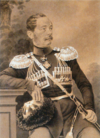
Nikolay Muravyov-Amursky
(1809–1881)
 Russian Empire
Russian Empire
statesman, diplomat, explorer of the Russian Far EastIn 1847 Nikolay Muravyov was appointed the Governor General of Eastern Siberia. He pursued the Russian exploration and settlement of the territories north of the Amur River. He assisted in organisation of Gennady Nevelskoy's expeditions, which led to the Russian presence near Amur estuary and on Sakhalin. In 1854 the military troops sailed down the Amur, and in 1855 the first settlers reached the river mouth. In 1856 the city of Blagoveshchensk was founded on Amur. During the last expedition of 1858, Muravyov concluded the Treaty of Aigun with China, which recognised Amur River as a border between the two countries and granted Russia an easier access to the Pacific Ocean. The new territories acquired by Russia included Priamurye and most of the territories of modern Primorsky and Khabarovsk Krais. For this achievement Muravyov was granted the title of Count Amursky (i.e., "of the Amur River"). The Treaty of Aigun was confirmed and expanded by the provisions of the Beijing Treaty of 1860, which granted Russia right to the Ussuri krai and southern parts of Primorye. To defend the new lands Muravyov created the Amur Cossacks corps.[83][84]
Muravyov-Amursky Peninsula has been named after Muravyov-Amursky. Boats of Muravyov's first expedition off Aigun
Boats of Muravyov's first expedition off Aigun
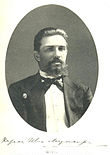
Ivan Mushketov
(1850–1902)
 Russian Empire
Russian Empire
geologist, geographer, explorer of Central Asia, Siberia, the Urals and the CaucasusIn 1873-79 Mushketov traveled extensively in the Central Asia, discovering and cataloguing mineral deposits. He produced the first geological map of Turkestan (together with S. Romanovsky). Mushketov also started observations of earthquakes in Kazakhstan, organized regular observation of the glaciers of the Caucasus, and researched the gold mines of the Urals. He led the team that surveyed the territory for the future Circum-Baikal Railway.[85]
A glacier and a mountain in Antarctica, a glacier in the Tian Shan Mountains, and a mountain in Buryatia are named after Mushketov.N
Contents: Top · 0–9 A B C D E F G H I J K L M N O P Q R S T U V W X Y Z
Portrait Person Achievements Image 
Ivan Nagurski
(1888–1976)
 Russian Empire
Russian Empire
 Poland
Poland
engineer, Russian Imperial Navy officer, pioneer of aviation, Arctic explorerNagurski was among the first pilots of the Imperial Russian Navy. In 1914 Nagurski was tasked with the difficult mission of locating the expeditions of Georgy Sedov, Georgy Brusilov, and Vladimir Rusanov in the Russian Arctic. Between August 21 and September 13, 1914, he flew five missions, spending more than ten hours in the air and travelling more than a thousand kilometres over land and the Barents Sea reaching as far as the 76th parallel north. Nagurski failed to find the expeditions, but he became the first polar aviator in history, and his experience was of much value to the subsequent polar flights. Later Nagurski performed the first ever loop with a flying boat, took part in the First World War and the Russian Civil War, and was thought dead for several decades until regaining his fame in 1950s.[86]
Nagurskoye meteorological station in Franz Josef Land was named after Nagurski.
Gennady Nevelskoy
(1813–1876)
 Russian Empire
Russian Empire
Russian Imperial Navy officer, Admiral, explorer of the Russian Far EastIn 1848 Nevelskoy led the expedition in the Russian Far East, exploring the area of Sakhalin and the Amur Liman (which he found possible to sail through on the tall ships). He proved that the Strait of Tartary was not a gulf, but indeed a strait, connected to Amur's estuary by a narrow section later called Nevelskoy Strait. Not knowing about the efforts of Japanese navigator Mamiya Rinzo who explored the same area forty years earlier, the Russians took Nevelskoy's report as the first proof that Sakhalin is indeed an island. In 1850 Nevelskoy founded Nikolayevsk-on-Amur, the first Russian settlement in the lower Amur River region. He also founded several military posts on Sakhalin. For that Nevelskoy is credited as one of the key figures in the Russian colonisation of Primorsky Krai and Sakhalin.[87]
Nevelskoy Strait, a city of Nevelsk on Sakhalin and Nevelskoy Marine State University in Vladivostok have been named after Gennady Nevelskoy.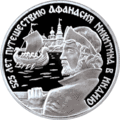
Afanasy Nikitin
(?–1472)
 Principality of Tver
Principality of Tver
merchant, early European traveler to Persia and IndiaIn 1466, Nikitin left his hometown of Tver on a commercial trip to India. He traveled down the Volga River, reached Derbent, then Baku and later Persia by crossing the Caspian Sea, where he lived for a year. In 1469 Nikitin arrived to Ormus and then, crossing the Arabian Sea, reached the sultanate of Bahmani, where he lived for 3 years. On his way back, Nikitin visited the African continent (Somalia), Muscat, Trabzon and in 1472 arrived at Feodosiya by crossing the Black Sea. Thus Nikitin became one of the first Europeans to travel to and to document his visit to India. He described his trip in a narrative known as A Journey Beyond the Three Seas (Khozheniye za tri morya). Nikitin had studied the population of India, its social system, government, military (he witnessed war-games featuring war elephants), its economy, religion, lifestyles, and natural resources. Nikitin's book provide a valuable source of information about India at that time.[88]
There are monuments to Nikitin in his hometown of Tver and in Revdanda near Mumbai in India. In 1958, Mosfilm produced a film A Journey Beyond the Three Seas. In 2006-07, the Indian organization "Adventures & Explorers" sponsored the "Nikitin Expedition", in which 14 travellers set out from Tver to retrace Nikitin's journey beyond the three seas.O
Contents: Top · 0–9 A B C D E F G H I J K L M N O P Q R S T U V W X Y Z
Portrait Person Achievements Image 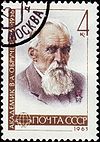
Vladimir Obruchev
(1863–1956)
 Russian Empire
Russian Empire
 Soviet Union
Soviet Union
geologist, geographer, explorer of Siberia and Central Asia, science fiction authorHaving graduated from the Petersburg Mining Institute in 1886, Obruchev went to Siberia. He studied gold-mining and assisted in constructing Central Asian and Trans-Siberian Railways. In Central Asia he explored the Kara Kum Desert, the shores of the Amu Darya River, and the old riverbeds of the Uzbois. In 1892-94 Obruchev took part in the Grigory Potanin's expedition to Mongolia and North China. He explored the Transbaikal area, Dzhungaria and Altai Mountains. Having spent half a century in exploring Siberia and Inner Asia, Obruchev summarized his findings in the extensive work The Geology of Siberia. He studied the origins of loess, the ice formation and permafrost, and the tectonics of Siberia. All together, he authored over a thousand scientific works. Obruchev is also known as the author of two popular science fiction novels, Plutonia (1915) and Sannikov Land (1924). These stories, imitating the pattern of Arthur Conan Doyle's The Lost World, depict in vivid detail the discovery of an isolated world of prehistoric animals in hitherto unexplored large islands in the Arctic.[89]
Obruchevite mineral, Akademik Obruchev Range in Tuva, a mountain near the upper Vitim River, an oasis in Antarctica, Obruchev crater on the Moon, the Obruchev Prize for works in the field of Siberian geology, Vladimir Obruchev oil and gas research vessel and many streets and other places have been named after Obruchev. Sannikov Land as it is presented in Obruchev's book
Sannikov Land as it is presented in Obruchev's book
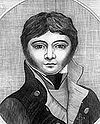
Dmitry Ovtsyn
(? – after 1757)
 Tsardom of Russia
Tsardom of Russia
 Russian Empire
Russian Empire
Russian Imperial Navy officer, hydrographer, Arctic explorerIn 1737-38 Ovtsyn led one of the units of the Great Northern Expedition that charted the coastline of the Kara Sea east of the Ob River, making the first hydrographic description of the large Gydan Peninsula and part of Taymyr. In 1741-42 Ovtsyn took part in Vitus Bering's voyage to the shores of North America.[90]
A cape on the Taimyr Peninsula and a strait between the islands Oleniy and Sibiryakov bear Ovtsyn's name.Location of the Gydan Peninsula
P
Contents: Top · 0–9 A B C D E F G H I J K L M N O P Q R S T U V W X Y Z
Portrait Person Achievements Image 
Pyotr Pakhtusov
(1800–1835)
 Russian Empire
Russian Empire
Russian Imperial Navy officer, hydrographer, Arctic explorer
(a monument in Kronstadt)A participant of the earlier explorations by Fyodor Litke, Pakhtusov led two expeditions to Novaya Zemlya in 1832 and 1835. He twice wintered on the islands and took detailed meteorological observations. Together with fellow explorer and cartographer Avgust Tsivolko, Pakhtusov made the first reliable maps of Novaya Zemlya's southern shores.[91]
An island on the eastern shore of Novaya Zemlya and a group of islands in the Nordenskiöld Archipelago are named after Pakhtusov.Location of Novaya Zemlya
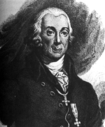
Peter Simon Pallas
(1741–1811)
 Prussia
Prussia
 Russian Empire
Russian Empire
naturalist, zoologist and botanist, geographer, explorer of European Russia and SiberiaBorn in Berlin and educated at German universities, Pallas was ivited by Catherine II of Russia to became a professor at the St Petersburg Academy of Sciences. In 1768-74, he led an academic expedition to central Russian provinces, Povolzhye, Caspian Sea, Urals, and Siberia, reaching as far east as Transbaikal. The regular reports which Pallas sent to St. Petersburg covered a wide range of topics, including geology and mineralogy, native peoples and religions, new plants and animals. Pallas became a favourite of Catherine II, and was provided with the specimens collected by other naturalists to compile the Flora Rossica (publ. 1784-1815) and Zoographica Rosso-Asiatica (1811–31). He also published an account of Johann Anton Güldenstädt's travels in the Caucasus and journals of Georg Wilhelm Steller from Kamchatka and Alaska. In 1793-94 Pallas led an expedition to southern Russia, visiting the Crimea and the Black Sea, the Caucasus and the valley of the Dnieper. He discovered and described a large number of new specimen and amassed a vast natural history collection.[92]
Streets in Berlin and Castrop-Rauxel, a city of Pallasovka in Volgograd Oblast, an asteroid 21087 Petsimpallas were named after Pallas, as well as many animals, including Pallas's Cat, Pallas's Squirrel, Pallas's Gull and others.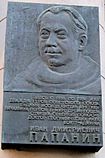
Ivan Papanin
(1894–1986)
 Russian Empire
Russian Empire
 Soviet Union
Soviet Union
Soviet Navy officer, Counter Admiral, twice Hero of the Soviet Union, Arctic explorer
(On photo: a monument to Ivan Papanin on the street of his name in Murmansk)In 1931 Papanin took part in the expedition of the icebreaker Malygin to the Franz Josef Land. In 1932-33 he was the chief of a polar expedition in the Tikhaya Bay on the Franz Josef Land. In 1934-35 he was the head of a polar station on the Cape Chelyuskin. In 1937-38 he was the head of the first Soviet manned drifting ice station North Pole-1, the world's first expedition of such kind. Together with Ernest Krenkel, Evgeny Fedorov and Petr Shirshov he landed on to the Arctic drifting ice-floes in an airplane flown by Mikhail Vodopyanov. For 234 days the team carried out a wide range of scientific observations in the near-polar zone, until taken back. In 1939-46 Papanin became the head of the Glavsevmorput', an establishment that oversaw operations on the Northern Sea Route. In 1940 he organized the expedition that rescued ice-trapped icebreaker "Sedov", and subsequently he headed various naval institutions.[93]
A cape on the Taymyr Peninsula, a mountain in Antarctica, an underwater mountain in the Pacific Ocean, a number of streets and an ice-class cargo and research ship have been named after Papanin.Maksim Perfilyev
(? – after 1638)
 Tsardom of Russia
Tsardom of Russia
Siberian Cossack voevoda, explorer of Eastern SiberiaIn 1618-19 Perfilyev became a co-founder of Yeniseysky ostrog, the first Russian fortress at the central Yenisey River and a major standpoint for further expeditions eastward. In 1618-27 Perfilyev made several journeys on Angara, Ilim, Lena and Vitim rivers, and built several new ostrogs. In 1631 he founded Bratsky ostrog (follow-up Bratsk). In 1638 he became the first Russian to step in Transbaikalia.[94][95]
The Maksimikha Bay at Lake Baikal (part of Barguzin Bay), Cape Maksimin and a village Maksimikha there (founded by Perfilyev ans his Buryat wife), as well as the village of Maksimovschina on Irkut River are named after Maksim Perfilyev.Yakov Permyakov
(? – 1712)
 Tsardom of Russia
Tsardom of Russia
Siberian Cossack, seafarer, merchant, Arctic explorerIn 1710, while sailing from the Lena River to the Kolyma River, Permyakov discovered the Medvyezhi Islands, siting them from afar. During the same voyage he also observed the follow-up Bolshoy Lyakhovsky island, known to the earlier explorers but never reached so far. In 1712, Permyakov and his companion Merkury Vagin crossed the Yana Bay from the mouth of the Yana over the ice and explored Bolshoy Lyakhovsky island, the southernmost of the New Siberian Islands. Thus they initiated the exploration of the large New Siberian archipelago. On their way back Permyakov and Vagin were murdered by mutineering expedition members.[96] Ivan Petlin
(? – after 1619)
 Tsardom of Russia
Tsardom of Russia
Siberian Cossack, diplomat, explorer of Central Asia and ChinaPetlin was the first Russian to reach China on an official diplomatic mission in 1618-19. His expedition may have been the second European expedition to reach China from the west by an overland route (after that of Bento de Góis) since the fall of the Yuan Dynasty. Together with Andrei Mundov and 10 other men, Petlin went south up the Ob River, crossed the Abakan Range, went south to Tuva and rounding Lake Ubsa reached the court of the Altyn Khan. Then they passed through Mongolia to the Great Wall of China and Peking. He was not allowed to see the Wanli Emperor because of not bringing proper tribute, so he returned back. He brought back a letter in Chinese inviting Russians to open trade, but no one in Russia was able to read it until 1675. A vague but still valuable account of Petlin's expedition was translated into English and published in Samuel Purchas' Pilgrims in 1625, and then translated to other European languages.[51][97] 
Valeri Polyakov
(born 1942)
 Soviet Union
Soviet Union
 Russian Federation
Russian Federation
cosmonaut and physician, Hero of the Soviet Union, Hero of the Russian FederationPolyakov holds the world record for the longest continuous spaceflight in history, 437 days 18 hours (more than 14 months), which he spent aboard Soyuz TM-18, Mir space station and Soyuz TM-20 in 1994-95. With his earlier expedition to Mir on Soyuz TM-6 and back on Soyuz TM-7 in 1988-89, his combined space experience is more than 22 months.[98] 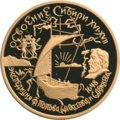
Fedot Popov
(? – 1648-54)
 Tsardom of Russia
Tsardom of Russia
merchant, explorer of Siberia and the Russian Far EastAn agent of Moscow merchant Alexey Usov, Fedot Popov came to Srednekolymsk in Siberia in 1645. There he organized an expedition eastward, and carried in Semyon Dezhnev. In 1648 they sailed down to the Arctic and became the first to pass through the Bering Strait and to discover Chukotka and Bering Sea. All their kochs and most of their men (including Popov himself) were lost in storms and clashes with the natives. A small group led by Dezhnyov reached the Anadyr River. In 1653-54, while fighting with Koryaks near Anadyrsk, Dezhnyov captured Popov's Yakut wife, who confirmed him dead. When Vladimir Atlasov came to conquer Kamchatka in 1697, he heard from the locals about a certain Fedotov, who had lived with his men near Kamchatka River and had married local women - so the Fedotov legend appeared. Gerhardt Friedrich Müller thought he was probably Fedot's son, while Stepan Krasheninnikov thought he was Fedot himself, thus deeming Fedot Popov to be the possible discoverer of Kamchatka.[32]  1773 map of Chukotka, showing the 1648 route of Popov and Dezhnyov
1773 map of Chukotka, showing the 1648 route of Popov and Dezhnyov
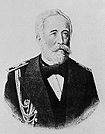
Konstantin Posyet
(1819–1899)
 Russian Empire
Russian Empire
Russian Imperial Navy officer, Admiral, military writer, statesman, diplomat, explorer of Pacific, Japan and the Russian Far EastIn 1852-54, Possiet journeyed on the frigate Pallas to Japan under the command of admirals Yevfimy Putyatin and Ivan Unkovsky. Accompanied also by novelist Ivan Goncharov and inventor Alexander Mozhaisky, Possiet explored and mapped the northern coastline of the Sea of Japan, including Possiet Bay, which now bears his name. In 1856 he carried to Japan the news of the ratification of the Treaty of Shimoda. Possiet's journeys and published observations made an expert on Japan in Russia. In 1875, already a Minister of Ways and Communications of Russia, he negotiated with Enomoto Takeaki the Treaty of Saint Petersburg, which brought entire Sakhalin Island into the Russian fold. He prepared the construction of the Trans-Siberian Railway and was a leading advocate for the restoration of the familiar white-blue-red tricolor as the official flag of Russia in 1896.[99][100]
Possiet Bay in the Sea of Japan, Posyet port there, and a street in Vladivostok are named after Konstantin Posyet.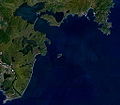 Possiet Bay in the Russian Far East
Possiet Bay in the Russian Far East

Grigory Potanin
(1835–1920)
 Russian Empire
Russian Empire
geographer, ethnographer, botanist, explorer of Siberia, Central Asia and ChinaPotanin traveled extensively through Siberia, studying its nature and peoples, once accompanied by Nikolai Yadrintsev. In 1876 and 1879 Potanin led two expeditions into Mongolia, obtaining valuable material in all fields of geography. In 1884-86 Potanin explored the Northern China and Tibet, returning to Russia through Qilian Mountains and Mongolia. They encountered a Turkish people called the Salars and made other ethnographic and geographic discoveries, including the first account of East and West Uighur languages. In 1989 Potanin became one of the founders of Tomsk University, the first university in Asian Russia. In 1892-93 he again explored the Northern China and Sichuan accompanied by geologist Vladimir Obruchev. Before reaching Tibet, Potanin was forced to turn back because of the illness and death of his wife Alexandra, who was the first woman in the Russian Geographical Society. In 1899 Potanin travelled onto Greater Khingan.[101]
A ridge in Qilian Mountains in China, the largest glacier in Altai Tavan Bogd (Altai Mountains), a number of streets in Siberian cities, several dozens of plants and 9915 Potanin asteroid were named after Potanin.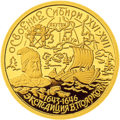
Vassili Poyarkov
(? – after 1668)
 Tsardom of Russia
Tsardom of Russia
Siberian Cossack ataman, explorer of Eastern Siberia and the Russian Far EastIn 1643, Poyarkov with 133 men were sent from Yakutsk to explore new lands south of Stanovoy Ridge. Having no idea of the proper route, Poyarkov traveled up the rivers Lena, Aldan, Uchur, Gonam and passed over the Stanovoy watershed only by winter, reaching the upper Zeya River in the country of Daurs, who were paying tribute to Manchu Chinese. After wintering, in 1644 Poyarkov pushed down the Zeya and became the first Russian to reach the Amur River. He reached the Gilyak country and discovered the mouth of the Amur River from land. Since his Cossacks provoked the enmity of the locals behind, Poyarkov chose different way back. They built boats and in 1645 sailed along the Sea of Okhotsk coast to the Ulia River and spent the next winter in the huts that had been built by explorer Ivan Moskvitin six years earlier. In 1646 they returned to Yakutsk.[102]  Amur River watershed
Amur River watershed
Gavriil Pribylov
(? – 1796)
 Russian Empire
Russian Empire
navigator, explorer of Alaska and Bering SeaPribylov, a commander of the ship St. George, led an expedition funded jointly by Grigory Shelikhov and Pavel Lebedev-Lastochkin with an aim to find the lucrative breeding grounds of fur seals, long sought by Siberian merchants. Pribylov discovered St. George Island in the Bering Sea in 1786, by following the sounds of barking northern fur seals and possibly hinted by Aleutian natives. Mixed Russian and Aleut crew of St. George established the international hunting for northern fur seals (continued for over a century until banned by international treaty in 1911). A year later in 1787, Pribylov discovered St. Paul Island 50 miles to the north of St. George.[103][104]
Pribilof Islands (St. George Island and St. Paul Island) are named after Pribylov.
Vasili Pronchishchev
(1702–1736)
 Tsardom of Russia
Tsardom of Russia
 Russian Empire
Russian Empire
Russian Imperial Navy officer, Arctic explorer
(forensic facial reconstruction)In 1735-36 Pronchishchev led one of the units of the Great Northern Expedition that discovered and mapped more than 500 of the Arctic shore to the west of the mouth of Lena River. He took his wife Maria Pronchishcheva with himself, aboard the sloop Yakutsk. Despite the difficulties, they reached Taymyr in 1736, having discovered the follow-up Faddey Islands, Komsomolskoy Pravdy Islands, Saint Peter Islands, and the east of Byrranga Mountains on Taymyr. Pronchishchev and his wife died from illness on the way back and were buried in the mouth of the Olenek River[25]
A part of the eastern coastline of the Taymyr Peninsula, a lake and a cape in the east of Taymyr, a ridge between the mouths of the Olenek and Anabar Rivers, and icebreaker Vasili Pronchishchev bear Pronchishchev's name.
Maria Pronchishcheva
(1710–1736)
 Tsardom of Russia
Tsardom of Russia
 Russian Empire
Russian Empire
first female Arctic explorer
(forensic facial reconstruction)Maria Pronchishcheva (or Tatiana according to some sources) accompanied her husband Vasili Pronchishchev in 1735-36, during the Great Northern Expedition, when they explored the coastline west of the mouth of Lena River, making many discoveries. She is considered to be the first female explorer of Arctic. Maria died from illness on the way back, only 14 days after the death of her husband Vasili.[25]
Maria Pronchishcheva Bay of Taymyr in the Laptev Sea is named after Pronchishcheva.Location of Maria Pronchishcheva Bay
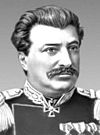
Nikolai Przhevalsky
(1839–1888)
 Russian Empire
Russian Empire
(Polish descent)
Imperial Russian Army officer, Major General, geographer, naturalist, explorer of Central Asia and ChinaIn 1867-69 Przhevalsky led an expedition to the basin of Ussuri River in the Far East. Subsequently he made a four major journeys to largely unknown parts of Central Asia, in the total covering more than 40,000 km in length. In 1870-73 he crossed the Gobi desert to Beijing, explored the upper Yangtze River, and crossed into Tibet, surveying over 18,000 km2 and collecting some 5,000 plants species, 1000 birds, 3,000 insects, 70 reptiles and the skins of 130 different mammals. The results of this journey were highly appreciated in Russia, both by Geographical Society and Russian military. In 1876-77, travelling through Eastern Turkestan and the Tian Shan range, he visited Lake Lop Nor. In 1879-80 he traveled via Hami and the Qaidam basin to Lake Koko Nor. Passing over Tian Shan into Tibet, he was short of 260 km from Lhasa before being turned back by Tibetan officials. In 1883-85 Przhevalsky traveled across Gobi to Alashan and Tian Shan, then back to Koko Nor, and westwards to Lake Issyk Kul. His journeys opened a new era for the study of geography, fauna and flora of Central Asia. He was the first to report on the wild population of Bactrian Camels, to describe the Przewalski's Gazelle and the Przewalski's Horse (the only extant wild horse).[84][105]
Przewalski's Gazelle, Przewalski's Horse and other species, a ridge in Kunlun, a glacier in Altai, Przhevalsk town (now Karakol) in Kyrgyzstan and his native Przhevalskoye viilage in near Smolensk have been named after Przhevalsky.
Yevfimy Putyatin
(1803–1883)
 Russian Empire
Russian Empire
Russian Imperial Navy officer, Admiral, diplomat, explorer of Pacific, Japan and the Russian Far EastIn 1822-25 Putyatin sailed with Mikhail Lazarev around the world aboard Suvorov. Later he led diplomatic missions to Iran and the Caucasus. Together with Admiral Ivan Unkovsky they led a scientific expedition on the frigate Pallada through the Atlantic, Indian and Pacific Oceans to Japan in 1852-55. This expedition contributed many important discoveries in oceanography. One of the results achieved was the Treaty of Shimoda between Japan and Russia. In 1857-58 Putyatin twice traveled to both Japan and China and explored Peter the Great Gulf, Russky Island, Eastern Bosphorus and other features of the Russian shores of the Sea of Japan.[2][99]
An island in the Peter the Great Gulf (Russian Far East), a cape in Anadyr Bay (Bering Sea) and a number of ships have been named after Putyatin.Demid Pyanda
(? – after 1637)
 Tsardom of Russia
Tsardom of Russia
Siberian Cossack ataman, explorer of Eastern SiberiaComing from Mangazeya, Demid Pyanda was a great hunter for Siberian furs. Starting his long journey from Turukhansk, in three and a half years from 1620 to 1624 Pyanda passed the total of 8000 km of hitherto unknown large Siberian rivers. He explored some 2300 km of Lower Tunguska (Nizhnyaya Tunguska in Russian) and, having reached the upper part of Tunguska, he discovered the great Siberian river Lena and explored some 2400 km of its length. When doing this, he became the first Russian to reach Yakutia and meet Yakuts. He returned back up Lena until it became too rocky and shallow, and by land reached Angara. On this way, Pyanda became the first Russian to meet Buryats. He built new boats and explored some 1400 km of Angara, finally discovering that Angara (a Buryat name) and Upper Tunguska (Verkhnyaya Tunguska, as initially known by Russians) are one and the same river.[106] R
Contents: Top · 0–9 A B C D E F G H I J K L M N O P Q R S T U V W X Y Z
Portrait Person Achievements Image 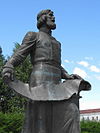
Semyon Remezov
(c. 1642 – after 1720)
 Tsardom of Russia
Tsardom of Russia
cartographer, geographer, historian, explorer of Siberia
(a monument in the Tobolsk Kremlin)In 1683-1710 Remezov described and mapped the Tobolsk region, where he was born. He wrote the Remezov Chronicle, one of the earliest historical accounts of Siberia and its exploration, a part of Siberian Chronicles. In 1699-1701 he created the Chart book of Siberia, the first large format cartographic atlas of Siberia. Apart from that he made more than two hundreds of charts and maps of eastern Russian regions.[107] 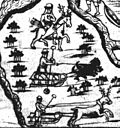 Siberian peoples as depicted in the Remezov Chronicle
Siberian peoples as depicted in the Remezov Chronicle
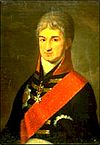
Nikolai Rezanov
(1764–1807)
 Russian Empire
Russian Empire
statesman, diplomat, explorer of Alaska and North PacificRezanov was one of the founders of Russian-American Company in 1799, formed on the basis of Shelikhov-Golikov Company. In 1803-06, made an ambassador to Japan by Emperor Alexander I, Rezanov co-led the first Russian circumnavigation of the world, aboard Nadezhda under the captaincy of Ivan Krusenstern, together with Yuri Lisianski on Neva. Rezanov was in command as far as Kamchatka. After his embassy to Japan failed, he was made an inspector of Russian colonies in America. In 1806 he sailed to San Francisco and managed to open a trade with Spanish California, concluded a treaty and engaged with Concepción Argüello, the daughter of the comandante of San Francisco. Rezanov died in Siberia, however, on journey back to St. Petersburg carrying the treaty to the capital.[108]
Rezanov's love affair with Concepción Argüello inspired a ballad by the San Francisco author, Francis Bret Harte, and a 1937 novel, Rezánov and Doña Concha, by another SF author, Gertrude Atherton, as well as a very successful Russian rock opera Juno and Avos by the composer Alexei Rybnikov and the poet Andrey Voznesensky in 1979.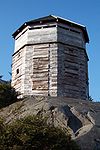 A replica of Russian trading post in New Archangel (Sitka, Alaska).
A replica of Russian trading post in New Archangel (Sitka, Alaska).

Voin Rimsky-Korsakov
(1822–1871)
 Russian Empire
Russian Empire
Russian Imperial Navy officer, hydroghafer and geographer, explorer of the Russian Far EastA senior brother of Nikolai Rimsky-Korsakov (famous composer and conductor), Voin Rimsky-Korsakov became a naval officer. In 1839 he took part in the describing of Finland shores. Later he was the commander of schooner Vostok in flotilla under administration of Admiral Yevfimy Putyatin. In 1850s and 1860s Rimsky-Korsakov explored the area of the Sea of Japan near Ussuri Krai, including the Sakhalin Island, the Amur Liman and the Strait of Tartary. Later he also surveyed the shores of Kamchatka and Kuril Islands.[109]
Rimsky-Korsakov Archipelago in the Sea of Japan has been named after Voin Rimsky-Korsakov.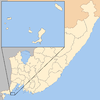 Rimsky-Korsakov Archipelago in the Sea of Japan
Rimsky-Korsakov Archipelago in the Sea of Japan
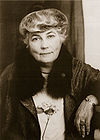
Helena Roerich
(1879–1955)
 Russian Empire
Russian Empire
 United States
United States
 India
India
philosopher, writer, public figure, traveler, explorer of Central Asia, China and IndiaHelena Roerich was an organizer and participant of cultural and enlightened creativity in the U. S., conducted under the guidance of her husband, Nicholas Roerich. Along with her husband, she took part in expedition to the little-investigated regions of Central Asia in 1924-28. She was an Honorary President-Founder of the Institute of Himalayan Studies «Urusvati» in India and co-author of idea of the International Treaty for Protection of Artistic and Scientific Institutions and Historical Monuments (Roerich’s Pact).[110]
Various institutions, minor planet 4426 Roerich, peak Urusvati in Altai Mountains and pass in Tian Shan were named after Helena Roerich. Altai, peaks and passes named in honor of the Roerich family
Altai, peaks and passes named in honor of the Roerich family

Nicholas Roerich
(1874–1947)
 Russian Empire
Russian Empire
 United States
United States
 India
India
painter, philosopher, archeologist, writer, public figure, traveler, explorer of Central Asia, China and IndiaA famous Russian painter, Roerich emigrated to the U. S. after Russian Revolution. By sale of his paintings and writings, and gain from activity of his cultural and enlightener organizations in America, Roerich was able to collect the finance and led a major expedition to Central Asia in 1924-28. The expedition went through Sikkim, Kashmir, Ladakh, China (Xinjiang), Russia (including Moscow), Siberia, Altai, Mongolia, Tibet, unstudied areas of the Himalayas. Archeological and ethnographical investigations were conducted, dozens of new mountain peaks and passes were marked on maps, rarest manuscripts were found, and some of the best series of Roerich's paintings were created. In 1934–35 Roerich conducted an expedition in Inner Mongolia, Manchuria and China, collecting nearly 300 species of xerophytes, herbs, manuscript and archeological relics. Roerich was an author and initiator of an international pact for the protection of artistic and academic institutions and historical sites (Roerich’s Pact, 1935) and a founder of an international movement for the defence of culture. He created about 7,000 paintings and founded a number of scientific and cultural institutions in the United States, Europe and India.[110][111][112]
Roerich’s Pact, various institutions, minor planet 4426 Roerich, a peak and a pass in Altai Mountains, two passes and a glacier in Tian Shan were named after Nicholas Roerich. Song of Shambhala by N. Roerich
Song of Shambhala by N. Roerich
 Institute of Himalayan studies “Urusvati”, founded by Roerichs
Institute of Himalayan studies “Urusvati”, founded by Roerichs
Vladimir Rusanov
(1875–1913?)
 Russian Empire
Russian Empire
geologist, Arctic explorerIn 1909-11 Rusanov carried out explorations in Novaya Zemlya archipelago. In 1912 he commanded a government expedition to Svalbard to investigate its coal reserves. They sailed on a small ship Herkules under Captain Alexander Kuchin, Roald Amundsen's South Pole expedition navigator. Concluding the work, part of the expedition members returned to Russia via Norway, while the rest without consultation with the authorities in St. Petersburg, set off with Rusanov in an incredibly rash attempt at reaching the Pacific via the Northern Sea Route, and disappeared in the Kara Sea. The relics of the expedition were found in 1937 in Kolosovykh Islands group. Soviet coal mining on Svalbard began in 1932.[113][114]
A glacier on Severnaya Zemlya, a bay and a peninsula on Novaya Zemlya, a mountain in Antarctic, streets in Moscow, Severodvinsk and Oryol (the city of Rusanov's birth) and several ships were named after Rusanov. Rusanov and his expedition are among the prototypes for the novel The Two Captains by Veniamin Kaverin, where the search proceedings for fictional captain Tatarinov resemble the search for Rusanov.Georgy Rybin
(1901–1974)
 Russian Empire
Russian Empire
 Soviet Union
Soviet Union
Soviet Navy officer, hydrographer, explorer of the Arctic and the Baltic SeaIn 1922-33 Rybin participated in hydrographic works on Ob and Yenisey Rivers. In 1922 he found the remnants of Peter Tessem, a lost member of Amundsen's expedition on Maud. Since 1933 he made hydrographic works on the Baltic, which became especially important during World War II and the Siege of Leningrad.[115]
Rybin-yaha River, flowing into the Gulf of Ob and charted by Rybin, and Rybin seamount in the Atlantic west of the Canary Islands, are named after Rybin.
Alexander Nevsky (Rurikid)
(1220–1263)
 Novgorod Republic
Novgorod Republic
 Vladimir-Suzdal
Vladimir-Suzdal
medieval Grand Prince of Novgorod and Vladimir, national hero and saint of Russia, traveler to Central AsiaA famous warrior, Russian Prince Alexander Yaroslavich Nevsky traveled into Mongolian capital Karakorum in Central Asia, between 1247–49, accompanied by his brother Andrey Yaroslavich. They were summoned there by Genghisid Khans who had conquered Rus' a few years before. Unlike their father Yaroslav II of Vladimir, who had come into Karakorum in 1245-46 and was poisoned by the Mongols, princes Alexander and Andrey were able to get back to Rus', confirmed in power by their new overlords. Russian princes were among the first known Europeans to travel so far into Asia, making their journey around the same time as Italian monk Plano Carpini traveled to Mongolia.[116]
Multiple churches, monasteries, streets, squares, ships and other objects are named after Alexander Nevsky in Russia. Alexander Nevsky by N. Roerich
Alexander Nevsky by N. Roerich
S
Contents: Top · 0–9 A B C D E F G H I J K L M N O P Q R S T U V W X Y Z
Portrait Person Achievements Image 
Anatoly Sagalevich
(born 1938)
 Soviet Union
Soviet Union
 Russian Federation
Russian Federation
deepwater explorer, Hero of the Russian Federation
(right on photo with Vladimir Putin)Since 1979 Sagalevich is the head of Deepwater Submersibles Laboratory at Shirshov Institute of Oceanology. He took part in the construction of Pisces VIII, Pisces IX and MIR Deep Submergence Vehicles (DSV) and completed more than 300 submersions as the chief pilot of DSVs. He piloted MIRs during expeditions to RMS Titanic, German battleship Bismarck, Soviet and Russian submarines K-278 Komsomolets and K-141 Kursk, and Japanese I-52. Sagalevich holds the world record for the deepest fresh water dive at 1637 m in Lake Baikal aboard a Pisces in 1990. On August 2, 2007, he was the pilot of MIR-1 DSV that reached the seabed at the North Pole during Arktika 2007 expedition.[117][118] 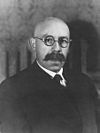
Rudolf Samoylovich
(1881–1940?)
 Russian Empire
Russian Empire
 Soviet Union
Soviet Union
geographer, Arctic explorerIn 1912 Samoylovich took part in Vladimir Rusanov's geological expedition to Spitsbergen. He was one of the initiators and the first director of the Arctic and Antarctic Research Institute in 1920-30 and 1932-38. He was also the founder and the first chairman of the Polar Countries' Department at Leningrad State University. In 1928 he was the head of the rescue party on the Krasin icebreaker, that saved most of the crew of Airship Italia of Umberto Nobile. Also, he participated in the polar flight of Graf Zeppelin in 1931 and headed expeditions on icebreakers Vladimir Rusanov (1932), Georgy Sedov (1934), and Sadko (1936 and 1937–38).[3][119]
A strait and a glacier top on Franz Josef Land, a bay on Novaya Zemlya, an island in Severnaya Zemlya, a mountain and a peninsula in the Antarctica bear Rudolf Samoylovich's name.Icebreaker Krasin among the ice floes in the Arctic
Yakov Sannikov
(1780 – after 1812)
 Russian Empire
Russian Empire
merchant, Arctic explorerSannikov is known for his explorations of the New Siberian Islands. In 1800, he discovered and charted Stolbovoy Island, and then Faddeyevsky Island in 1805. In 1809-1810, he took part in the expedition led by Matvei Gedenschtrom. During this expedition, in 1810, Sannikov crossed the island of New Siberia and a year later explored Faddeyevsky Island. He also discovered Bunge Land. He suggested that there was a vast land north of the Kotelny Island. Thus he introduced a theory about the existence of the legendary Sannikov Land.[120]
The legendary Sannikov Land, the Sannikov Strait strait between Maly Lyakhovsky and Kotelny islands and a street in Moscow bear Sannikov's name.
Gavriil Sarychev
(1763–1831)
 Russian Empire
Russian Empire
Russian Imperial Navy officer, navigator, Admiral, cartographer, explorer of the Russian Far East and AlaskaIn 1785-94 Sarychev took part in the expedition sponsored by Catherine II of Russia and led by Joseph Billings. Sarychev, a commander of ship Slava Rossii (Glory of Russia), described and mapped the coastline of the Sea of Okhotsk from Okhotsk to Aldoma and many of the Aleutian Islands (especially Unalaska). He also described the islands of Pribylov, St. Matthew Island, St. Lawrence Island, Gvozdev, and King Island. In 1802-06, Sarychev led the hydrographic expedition on the Baltic. He was also in charge of hydrographic research in Russia since 1808 and led the compilation of the Atlas of the Northern Part of the Pacific Ocean in 1826.[121]
Sarychev Peak of Matua Island in the Kuril Islands, as well as Cape Sarichef, Sarichef Strait and Sarichef Island in Alaska were named after Gavril Sarychev. The Soviet ship Gavril Sarychev also was named after this explorer. Russian Orthodox Church of the Holy Ascension in Unalaska
Russian Orthodox Church of the Holy Ascension in Unalaska

Svetlana Savitskaya
(born 1948)
 Soviet Union
Soviet Union
 Russian Federation
Russian Federation
female cosmonaut, aviator, twice the Hero of the Soviet Union, politician
(Savitskaya with her 1982 crew fellows Popov and Serebrov)Savitskaya was the second woman in space (after Valentina Tereshkova) and the first woman to conduct an extra-vehicular activity. She achieved this during the two successful expeditions to Salyut 7 space station in 1982 and 1984, making her spacewalk on July 25, 1984.[122]
Two minor planets № 4118 Sveta and № 4303 Savitskaya have been named after Svetlana Savitskaya.
Otto Schmidt
(1891–1956)
 Russian Empire
Russian Empire
 Soviet Union
Soviet Union
mathematician, astronomer, geophysicist, statesman, Hero of the Soviet Union, Arctic explorerIn 1932-39 Schmidt was the head of Chief Directorate of the Northern Sea Route. In 1929-30, travelling on the icebreaker Georgy Sedov, he established the first research station on the Franz Josef Land, explored the northwestern Kara Sea and western Severnaya Zemlya, discovering a few islands. In 1932 his expedition on the icebreaker Sibiryakov with Captain Vladimir Voronin made first non-stop voyage through the Northern Sea Route from Arkhangelsk to the Pacific Ocean without wintering. In 1933-34 Schmidt and Voronin led the voyage on the steamship Cheliuskin, that resulted in the loss of the ship and evacuation of the crew. In 1937 Schmidt supervised an airborne expedition that established a drift-ice station North Pole-1, and in 1938 he was in charge of evacuating its personnel from the ice.[123]
An island in the Kara Sea, a cape on in the Chukchi Sea, minor planet 2108 Otto Schmidt, an icebreaker, a number of scientific institutions and streets bear Schmidt's name.
Leopold von Schrenck
(1826–1894)
 Russian Empire
Russian Empire
zoologist, geographer, ethnographer, explorer of the Russian Far EastOn behalf of the Russian Academy of Sciences, Schrenck explored fauna of the Russian Far East, in Amurland between 1853–54, and on Sakhalin in 1854-55, discovering a number of animals. Later he turned to the study of native peoples of Russia. He coined the term Paleo-Asiatic peoples and was a director of Peter the Great Museum of Anthropology and Ethnography in St Petersburg.[84]
A mountain ridge on the Sakhalin and a number of animals including Amur sturgeon, Manchurian Black Water Snake and Manchurian Black Water Snake are named after Schrenck.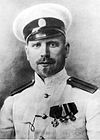
Georgiy Sedov
(1877–1914)
 Russian Empire
Russian Empire
Russian Imperial Navy officer, Arctic explorerIn 1902-03, Sedov took part in a hydrographic expedition in the Arctic. In 1909, he led the expedition that described the mouth of the Kolyma river. In 1910 he explored the Krestovaya Bay on Novaya Zemlya. He suggested a sleigh expedition to the North Pole and found the independent sponsors, as the government refused in the finance. In 1912 Sedov's ship "Svyatoy Muchenik Foka" (Saint Martyr Foka) sailed north but had to stay for the winter near Novaya Zemlya because of impassable ice. Sv. Foka reached Franz Josef Land, but had to stop for another winter due to lack of coal. In early 1914, Sedov, sick with scurvy, with two companions set off for the North Pole with the draft dogs. Near Rudolf Island Sedov died and was buried there, at Cape Auk. On the way back, at Franz Josef Land, the Sv. Foka rescued two survivors of the Georgy Brusilov expedition, Valerian Albanov and Alexander Konrad.[3]
Two gulfs and a peak on Novaya Zemlya, a glacier and a cape on Franz Josef Land, an island in the Barents Sea, a cape in Antarctica and a steam icebreaker Sedov were named after Sedov. He and his last expedition are among the prototypes for the novel The Two Captains by Veniamin Kaverin, where the fictional captain Tatarinov has Sedov-like appearance and shares his passion for Arctic exploration.
Pyotr Semyonov-Tyan-Shansky
(1827–1914)
 Russian Empire
Russian Empire
geographer, statistician, entomologist, explorer of Central AsiaSemyonov is known for his explorations of the then largely unknown mountains of the Tian Shan. In 1856-57 he passed through the Altay Mountains, visited the Issyk Kul and came to the Tian Shan. Semyonov was the first European to see the peak of Khan Tengri. He disproved Humboldt's earlier claims about Tian Shan's supposed volcanic origins. The next year, he published the first systematic description of the Tian Shan. The reputation of this monograph was such that half a century later Nicholas II of Russia authorized him to add the epithet "Tian-Shansky" (that is, "of Tian Shan") to his last name. For many years Semyonov served as Chairman of the Russia's Central Committee for Statistics. It was largely due to his efforts that the first census of the Russian Empire was held in 1897. Semyonov amassed a large collection of old Dutch masters, which now belongs to the Hermitage Museum as well as insect collection of ca. 700,000 specimens. He was a member of 53 learned societies and headed the Russian Geographical Society for 40 years from 1873 until his death, using this position to encourage the exploration of inland Asia, notably by Nikolai Przhevalsky and Pyotr Kozlov.[3][84][124]
More than 100 plant and animal species as well as a number of geographical objects in Central Asia, Alaska, the Caucasus and Svalbard were named after Semyonov.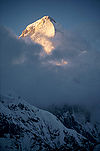 Khan Tengri at sunset
Khan Tengri at sunset
Yuri Senkevich
(1937–2003)
 Soviet Union
Soviet Union
 Russian Federation
Russian Federation
physician, scientist, traveler, TV anchorman
(photo of Senkevich on the cover of his memoirs A Lifelong Travel)Senkevich, being a Soviet military physician, participated in the 12th Soviet Antarctic expedition at Vostok station in 1966-67. In 1969 Senkevich sailed with Thor Heyerdahl on the Ra papyrus boat, and later on the Ra II across the Atlantic Ocean in 1970. He also sailed with Heyerdahl on another reed boat Tigris across the Indian Ocean in 1978. In 1973-2003, Senkevich was a host of the "Travelers' Club" show on the Soviet Television for the record 30 years, making it into the Guinness Book of Records. He visited more than 200 countries as a journalist and TV anchorman.[125] 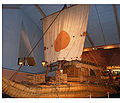 Ra II boat in the Thor Heyerdahl's Kon-Tiki Museum
Ra II boat in the Thor Heyerdahl's Kon-Tiki Museum
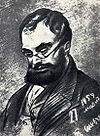
Nikolai Severtzov
(1827–1885)
 Russian Empire
Russian Empire
naturalist, explorer of Central AsiaSevertzov started as naturalist in his native Voronezh gubernia. In 1857-58, on an expedition to the Syr Darya in Central Asia, he was captured by Kokand bandits and severely wounded. He was freed after a month by the Russian military and continued his studies. In 1865-68 he explored the Tian Shan and Lake Issyk Kul. In 1877-78 he explored the unknown areas of Pamir Mountains following a route close to the current Pamir Highway as far as Lake Yashil Kul on the Ghunt River. Severtzov wrote a major study of Turkestan zoology called Vertical and horizontal distribution of Turkestan wildlife (1873), which included the first description of a number of animals.[84]
The Severtzov Argali (a wild sheep) has been named after Severtzov.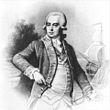
Grigory Shelikhov
(1747–1795)
 Russian Empire
Russian Empire
seafarer, merchant, explorer of the Russian Far East and AlaskaShelikhov organized commercial trips of the merchant ships to the Kuril Islands and the Aleutian Islands starting from 1775. Together with Ivan Golikov, Shelikhov founded the precursor of Russian-American Company (this name appeared in 1799 after Shelikhov death). In 1783-86, he led an expedition to the shores of Russian America, during which he founded the first permanent Russian settlements in North America. In 1784 Shelikhov arrived in Three Saints Bay on Kodiak Island. Having established the authority there, he founded the first permanent Russian settlement in Alaska. In 1790, Shelikhov, back in Russia, hired Aleksandr Baranov to manage his fur enterprise in Russian America.[126]
Shelikhov Bay in the Sea of Okhotsk, a strait between Alaska and Kodiak Island, and a town Shelekhov in Irkutsk Oblast in Russia bear Shelikhov's name. The settlement of Shelikhov on Kodiak
The settlement of Shelikhov on Kodiak
Pyotr Shirshov
(1905–1953)
 Russian Empire
Russian Empire
 Soviet Union
Soviet Union
oceanographer, hydrobiologist, statesman, academician, Hero of the Soviet Union, Arctic explorerShirshov participated in numerous Arctic expeditions, including the famous ones on icebreakers Sibiryakov (1932) and Chelyuskin (1934). He was among the crew of the drifting ice station North Pole-1 in 1937-38. In 1942-48, Shirshov was a Maritime Minister of the Soviet Union. In 1946-53, he became the founder and the first director of the Institute of Oceanology of the Soviet Academy of Sciences. He wrote numerous works about plankton in the polar regions and proved that there is life in high latitudes of the Arctic Ocean.[3]
A bay and a lake in the Franz Josef Land, an underwater range in the Bering Sea, a street in Dnepropetrovsk (the native city of Shirshov), two scientific vessels and Shirshov Institute of Oceanology bear Shirshov's name.Gleb Shishmaryov
(1781–1835)
 Russian Empire
Russian Empire
Russian Imperial Navy officer, circumnavigator, explorer of the AlaskaIn 1815-18 Shishmaryov accompanied Otto von Kotzebue on his circumnavigation, including the visit to Alaska. During this voyage a new-discovered inlet on Chukotka was named after Shishmaryov. In 1820 he returned to Alaska in command of ship Blagonamierennie, accompanied by Lt. Mikhail Vasiliev on ship Otkrietie. Shishmaref and Vasiliev entered the Chukchi Sea and explored the coast of Alaska from Kotzebue Sound to Icy Cape and later from Norton Sound to Cape Newenham. St. Lawrence Island was mapped on the return way.[2]
The town of Shishmaref, Alaska, and the Shishmaref Inlet in Chukotka bear Shishmaryov's name.
Nikolay Shkot
(1829–1870)
 Russian Empire
Russian Empire
Russian Imperial Navy officer, explorer of the Russian Far EastAfter being wounded in the Siege of Sevastopol during the Crimean War, Shkot served on the Far East. In 1956-63 he explored Sakhalin (especially the Moneron Island) and the coast of Primorsky Krai in the area of Peter the Great Gulf and Nakhodka Bay, making a number of discoveries. He founded hydrographic post on a place of modern Nakhodka, and was one of the founders of Vladivostok in 1860.[127]
Shkot Island in the Sea of Japan, Shkotovo village and Shkotovka River in Primorsky Krai, and a cape in Olga Bay are named after Shkot.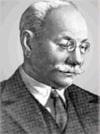
Yuly Shokalsky
(1856–1940)
 Russian Empire
Russian Empire
 Soviet Union
Soviet Union
Imperial Russian Navy officer, oceanographer, meteorologist, cartographer, geographer, explorer of European RussiaIn 1897-1901 Shokalsky researched Lake Ladoga. Since 1907 he supervised all oceanographic works in Russia. He coined the term World Ocean. In 1919 he headed the commission that set up time zones in Russia. In 1918-31 he was the head of Russian Geographical Society and contributed a lot to the Arctic exploration on this post.[128]
Shokalsky Strait in the Severnaya Zemlya, Shokalsky Island in the Kara Sea, two islands in the Kara Strait, a lake on Kanin Peninsula, a glacier in Novaya Zemlya and an ocean current around Svalbard are named after Shokalsky. A 1912 map of the Russian Empire by Shokalsky
A 1912 map of the Russian Empire by Shokalsky
Martin Shpanberg
(?–1761)
 Denmark
Denmark
 Tsardom of Russia
Tsardom of Russia
 Russian Empire
Russian Empire
Russian Imperial Navy officer, navigator, explorer of the Russian Far East and JapanShpanberg was born in Denmark and like Vitus Bering (another Danish) he joined the Russian Navy. He took part in the Russian exploration efforts in the Northern Pacific during the first Kamchatka expedition of Vitus Bering (1725–30). During the Second Kamchatka Expedition, also organised by Bering, Shpanberg was made a leader of expedition to find a sea route to Japan. In 1738-39 he explored and mapped most of Kuril islands and reached Japan, however he failed to establish the relations with Japanese and soon returned back.[129] 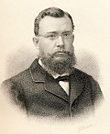
Alexander Sibiryakov
(1849–1933)
 Russian Empire
Russian Empire
 France
France
gold mine owner, explorer of Siberia and Arctic, sponsor of many expeditionsA rich gold mine owner from an ancient family of Siberian merchants, Sibiryakov financed the polar expeditions of Adolf Erik Nordenskiöld and A.V.Grigoriev. He also sponsored the publication of works on Siberia's history. In 1880, he made an attempt to enter the Yenisei estuary through the Kara Sea on a schooner. In 1884, Sibiryakov reached the Pechora estuary on the steamer "Nordenskiöld" and proceeded up the river. He also crossed the Urals using reindeers and reached Tobolsk by the Tobol River. Sibiryakov contributed significantly to Siberia's economic development.[130]
Sibiryakow Island in the Kara Sea near the mouth of the Yenisey, Sibiryakov Island in the Sea of Japan, Russian icebreakers Alexander Sibiryakov (the first to pass the Northern Sea Route in one navigation) and Sibiryakov have been named after Alexander Sibiryakov.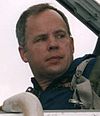
Anatoly Solovyev
(born 1948)
 Soviet Union
Soviet Union
 Russian Federation
Russian Federation
cosmonaut, aviator, Hero of the Soviet UnionSolovyev holds the world record on the number of spacewalks (16), and accumulated time spent spacewalking (over 82 hours), which he performed during his five spaceflights. In 1988 he traveled on Soyuz TM-5 to Mir space station and back on Soyuz TM-4. In 1990 he again traveled to Mir and back on Soyuz TM-9, and in 1990 made the similar journey on Soyuz TM-15. In 1995 he got to Mir on Space Shuttle STS-71 and went back on Soyuz TM-21, and in 1997-98 again traveled to Mir and back on Soyuz TM-26.[131][132]
Mikhail Somov
(1908–1973)
 Russian Empire
Russian Empire
 Soviet Union
Soviet Union
geographer, oceanologist, Hero of the Soviet Union, Arctic and Antarctic explorerMikhail Somov graduated from the Moscow Hydrometeorological Institute in 1937. In 1939, he was appointed senior researcher at the Arctic and Antarctic Research Institute. In 1950-51, Mikhail Somov headed a second Soviet drifting ice station North Pole-2. In 1955-57, he became a leader of the 1st Soviet Antarctic Expedition on icebreakers Ob and Lena. The expedition established the first Soviet Antarctic station, Mirny, performed some observations and reconnaissance, and researched oceanography of the Indian ocean. Somov was also the first Soviet delegate to the international Scientific Committee for Antarctic Research.[133]
A glacier in East Antarctica (Queen Maud Land), a scientific icebreaker and a minor planet 3334 Somov bear Somov's name.Mikhail Stadukhin
(?–1666)
 Tsardom of Russia
Tsardom of Russia
Siberian cossack leader, explorer of the north-eastern Siberia and the Russian Far EastIn 1633 Stadukhin came to the Lena River and then to Indigirka. With Semyon Dezhnyov he led a group to the Arctic coast and then to the east. They discovered Kolyma River and founded Srednekolymsk there in 1643. In 1649 he followed by Arctic Ocean the traces of Dezhnyov's and Fedot Alekseyev's expedition to the east, which started earlier in 1648 (and reached the Bering Strait). He learned from the captive natives that two of Dezhnyov's koches had been wrecked and the crews killed by the natives. Facing shortages in provision, Stadukhin returned to Srednekolymsk. Later he found the connection of Kolyma watershed to that of Anadyr and thus explored the land way to Chukotka. On Anadyr he found Dezhnyov in 1650. In 1651 he set off south and discovered the Penzhin Bay of northern Okhotsk Sea. He also may have explored the western shores of Kamchatka.[32] 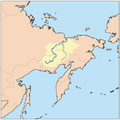 Location of Kolyma River
Location of Kolyma River
Georg Wilhelm Steller
(1709–1746)
 Holy Roman Empire
Holy Roman Empire
 Russian Empire
Russian Empire
botanist, zoologist, physician, explorer of the Russian Far East and AlaskaIn 1734 Steller, a naturalist, moved from Bavaria to Russia to work at the Saint Petersburg Academy of Sciences. Steller traveled trough Siberia, researching its nature, and in 1740 reached Okhotsk and Kamchatka. He joined Vitus Bering on the voyage to North America. The expedition landed in Alaska at Kayak Island in 1741, staying only long enough to take on fresh water. During this time Steller became the first European naturalist to describe a number of North American plants and animals, including the Steller's Jay. On the return journey the expedition was shipwrecked on Bering Island. Here Bering died, and almost half of the crew perished from scurvy. Despite the hardships, Steller studied the flora and fauna of the island in great detail. He collected the only existing detailed observations of the now extinct Steller sea cow, a large sirenian mammal. In the spring the crew constructed a new vessel and returned to Kamchatka, where Steller continued his research. He died on the journey to St. Petersburg, but his journals were published by Peter Simon Pallas and were later used by other explorers, including Captain Cook.[134]
Steller's Jay, Steller's (or Northern) Sea Lion, Steller's Sea Cow, Steller's Eider, the marine cryptid Steller's Sea Ape (never sighted by anyone but Steller), Steller's Sea Eagle and other animals have been named after Steller. Extinct Steller's Sea Cow drawn by Steller
Extinct Steller's Sea Cow drawn by Steller
Anikey Stroganov
(1488–1570)
 Grand Duchy of Moscow
Grand Duchy of Moscow
 Tsardom of Russia
Tsardom of Russia
rich merchant and landowner, colonizer of Perm Krai and UralsAnikey Stroganov was a progenitor of the famous Stroganovs family of highly successful Russian merchants, industrialists, landowners, and statesmen. He was a founder of numerous salterns in Solvychegodsk, Kola Peninsula and Perm. He colonized the basin of the Kama and Chusovaya Rivers. In the beginning of the reign of Tsar Ivan IV he received the right to control the trade with English merchants, traveling from Arkhangelsk to Moscow. Stroganov established trade routes with Siberian tribes. Tsar Ivan granted large estates near the Urals as well as tax privileges to Stroganovs, and they organized large scale migration to their new lands. They developed farming, hunting, saltworks, fishing, and ore mining. They built new towns and fortresses and annexed new lands in the Urals and Siberia in favor of Russia.[2] Semyon Stroganov
(?–1586)
 Grand Duchy of Moscow
Grand Duchy of Moscow
 Tsardom of Russia
Tsardom of Russia
rich merchant and landowner, coloniser of the Urals and SiberiaSemyon was the younger son of Anikey Stroganov. After the death of his father in 1570, Semyon quarreled with his brothers. Initially he was deprived of family wealth, however after the deaths of his brothers he received an appropriate part. He is most famous for the fact that together with his nephews he sponsored and prepared Yermak's expedition to conquer Siberia Khanate in 1581-85. After the success of Yermak and his followers, the Tsar granted new Siberian lands to the Stroganovs.[135] T
Contents: Top · 0–9 A B C D E F G H I J K L M N O P Q R S T U V W X Y Z
Portrait Person Achievements Image 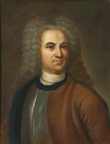
Vasily Tatishchev
(1686–1750)
 Tsardom of Russia
Tsardom of Russia
 Russian Empire
Russian Empire
statesman, geographer, ethnographer, historian, explorer of European Russia and the UralsIn the service of Peter the Great Tatishchev was sent to the Urals and there supervised the works on general geographical description of Russia. Subsequently new Empress Anna entrusted him with a lucrative office of the management of Ural factories. At that post he founded the cities of Perm and Yekaterinburg, which have since grown into the veritable capitals of Ural. Tatischev finished his career as a governor of Astrakhan (1741–44) and dedicated himself to Russian geography and historiography. He discovered and published several documents of great interest, e.g., Russkaya Pravda and Sudebnik of 1550. His magnum opus was the first sketch of Russian history, entitled Russian History Dating Back to the Most Ancient Times. He also compiled the first encyclopedic dictionary of the Russian language.[136]
A settlement and a district was named in his honour in Saratov Oblast.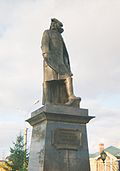 Monument to Tatischev in Perm
Monument to Tatischev in Perm
Mikhail Tebenkov
(1802–1872)
 Russian Empire
Russian Empire
Russian Imperial Navy officer, Vice Admiral, hydrographer, explorer of AlaskaTebenkov surveyed Norton Sound on behalf of the Russian Imperial Hydrographic Service in 1831 and was the first European to sight the bay that now bears his name. In 1845-50 he was the director of the Russian American Company and the governor of Russian America. Tebenkov created a detailed atlas of the western shores of Alaska, published in 1852.[137]
A bay, a glacier, a mount and a point on Alaska have been named after Tebenkov.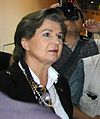
Valentina Tereshkova
(born 1937)
 Soviet Union
Soviet Union
 Russian Federation
Russian Federation
female cosmonaut, Hero of the Soviet Union, Major General, politician and public figureAboard Vostok 6 on 16 June 1963 Tereshkova became the first woman as well as the first civilian to travel into space. On this mission, lasting almost three days in space, she performed various tests on herself to collect data on the female body's reaction to spaceflight. She also maintained a flight log and took photographs of the horizon, which were later used to identify aerosol layers within the atmosphere.[138]
Tereshkova crater on the far side of the Moon and minor planet 1671 Chaika (her call sign in the flight, meaning seagull), as well as many streets and other places have been named after Valentina Tereshkova. A Soviet postage stamp dedicated to Vostok 6 and Tereshkova
A Soviet postage stamp dedicated to Vostok 6 and Tereshkova
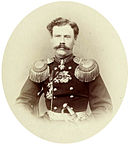
Aleksey Tillo
(1839–1900)
 Russian Empire
Russian Empire
geographer, cartographer, land surveyor, lieutenant general of the Russian Imperial Army, explorer of European RussiaTillo created the first correct hypsometric map of European Russia, published in 1889. He is known to have coined the term Central Russian Upland. Also, he measured the length of the main Russian rivers and conducted work on level difference of Caspian Sea and Sea of Aral. He authored a number of works on geomagnetism and meteorology.[139]
The Tillo Islands in the Kara Sea and an island near Wilczek Land in Franz Josef Land, were named after Tillo.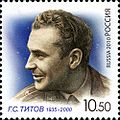
Gherman Titov
(1935–2000)
 Soviet Union
Soviet Union
 Russian Federation
Russian Federation
cosmonaut, Hero of the Soviet UnionAboard Vostok 2 on August 6, 1961, Titov became the fourth man in space after Yury Gagarin, Alan Shepard and Gus Grissom, and the second man to orbit the Earth, the first to do it multiple times (a total of 17), the first to spent more than a day in space, and the first person to drive a spaceship manually. He also was the first person to sleep in space and to suffer from space sickness. He made the first manual photographs from orbit, thus setting a record for modern space photography. A month short of 26 years old at launch, until this day he remains the youngest person to fly in space.[140]
A crater on the far side of the Moon and an island in Halong Bay are named after Titov. A monument on the place of Titov's landing near Saratov
A monument on the place of Titov's landing near Saratov
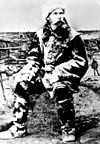
Eduard Toll
(1858–1902)
 Russian Empire
Russian Empire
(born in Estonia, Baltic German descent)
zoologist, paleontologist, geologist, Siberia and Arctic explorerIn 1885–86, Baron Toll took part in an expedition of Russian Academy of Sciences to the New Siberian Islands led by Alexander Bunge. In 1893 Toll led a major academic expedition to Yakutia and explored the region between lower Lena and Khatanga, the basins of Yana, Indigirka, and Kolyma, the plateau between the Anabar and Popigay Rivers, and the Vasily Pronchischev mountain ridge (named by Toll) between Olenek and Anabar. In 1899, Toll took part in a voyage of the icebreaker Yermak to Spitsbergen, led by Stepan Makarov. In 1900–02, Toll led an expedition on ship Zarya to find the legendary Sannikov Land. Due to severe ice conditions the expedition was forced to spend two winters in the Arctic. Toll traveled to Bennett Island by sledge and kayak with three companions, and they were lost. In 1903 the search led by Mikhail Brusnev and Aleksandr Kolchak brought out only the diaries and the collections of Toll's party.[55]
A bay at the north-west of Taymyr, Tollievaya River, a cape on Tsirkul Island, mountains in Novaya Zemlya, the northern cape at Stolbovoy Island, the strait and a plateau at Kotelny Island, the central ice cap of Bennett Island, and many specimens of fauna and flora are named after Baron Eduard Von Toll.Yevgeny Tolstikov
(1913–1987)
 Russian Empire
Russian Empire
 Soviet Union
Soviet Union
geographer, Hero of the Soviet Union, Arctic and Antarctic explorerTolstikov was involved in defending the Northern Sea Route during World War II. In 1954 he was the head of the drifting ice station North Pole-3 in the Arctic Ocean. In 1957-59 he became the leader of the 3rd Soviet Antarctic Expedition and the founder of Sovetskaya and Pole of inaccessibility research stations. This expedition discovered Gamburtsev Mountain Range and other features of Antarctica relief under the ice. He was the chief editor of the general atlas of Antarctic.[141]
A minor planet 3357 Tolstikov is named after Tolstikov.The Pole of inaccessibility Antarctic station
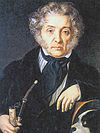
Fyodor Ivanovich Tolstoy
(1782–1846)
 Russian Empire
Russian Empire
nobleman, adventurer, traveler to Alaska and around the worldA count from the well-known Tolstoy family, Fyodor Tolstoy was famous for his unusual temper, gambling and passion for duels. In 1803 Tolstoy took part in the first Russian circumnavigation of the world on sloop Nadezhda , captained by Ivan Krusenstern. However, multiple quarrels with other members of the team and very bad behaviour, including the successful teaching a pet orangutan of how to cover the captain's longbook in ink, caused Tolstoy to be abandoned on a stop in Kamchatka with aforementioned ape, whose later fate is unknown. On a different ship Tolstoy managed to get into Sitka, Alaska, where he spent several months among Alaskan natives of the Tlinkit tribe and acquired multiple tattoos. Finally he returned to St Petersburg via Kamchatka and Siberia. His voyage to North America earned him nickname the American and a legendary celebrity due to the tales and gossip of his adventures.[142]
Tolstoy served as a prototype for a number of characters in the Russian literature, including the duellist Zaretsky in Eugene Onegin of Aleksandr Pushkin. An orangutan
An orangutan
Alexey Tryoshnikov
(1914–1991)
 Russian Empire
Russian Empire
 Soviet Union
Soviet Union
geographer, oceanologist, Arctic and Antarctic explorerTryoshnikov was involved in defending the Northern Sea Route during World War II and participated in the 1948 Soviet expedition to the North Pole. In 1954-55, he was the leader of the drifting ice station North Pole-3 in the Arctic Ocean. In 1956-58 he was a leader of the 2nd and in 1967-69 he led the 13th Soviet Antarctic Expedition. During the latter expedition Bellingshausen Station was founded. Tryoshnikov took part in the creation of the general atlas of Antarctic and then he was the main editor of the atlas of Arctic. He also was the president of the Geographical Society of the USSR since 1977 and the director of the Arctic and Antarctic Research Institute of the Soviet Union in 1960-81.[143]
A minor planet 3339 Treshnikov and a scientific vessel named after Tryoshnikov.Avgust Tsivolko
(1810–1839)
 Russian Empire
Russian Empire
Russian Imperial Navy officer, hydrographer, Arctic explorerIn 1832-34 Tsivolko participated in the Arctic expeditions led by Pyotr Pakhtusov. They made the first reliable maps of Novaya Zemlya's southern shores. It was Tsivolko who first mapped the Matochkin Strait between two main islands of Novaya Zemlya. In 1837 he commanded a schooner Krotov during the Karl Baer's expedition to Novaya Zemlya. In 1838 he was sent to map the northern and northeastern shores of Novaya Zemlya, but died from scurvy before this work was completed.[144]
A gulf in the Kara Sea and a group of islands in the Nordenskiöld Archipelago are named after Tsivolko.
Gombojab Tsybikov
(1873–1930)
 Russian Empire
Russian Empire
 Soviet Union
Soviet Union
anthropologist, ethnographer, statesmen, explorer of TibetA native Buryat, Tsybikov studied in Tomsk and St Petersburg Universities. In 1899-1902 he traveled to Tibet in a group of Buryat and Kalmyk Bhuddist pilgrims. He became the first photographer of Tibet, taking pictures in secret. These pictures were widely celebrated throughout the world, printed also by the National Geographic in the U. S. In 1904 Tsybikov served as a translator on Russian talks with Dalai Lama in Urga, Mongolia, presenting Dalai Lama with an edition of his pictures. Later Tsybikov published his travelogue with much valuable translations from Tibetan included.[145]
A number of streets in Buryatian settlements and a museum are named after Tsybikov.U
Contents: Top · 0–9 A B C D E F G H I J K L M N O P Q R S T U V W X Y Z
Portrait Person Achievements Image 
Ivan Unkovsky
(1822–1886)
 Russian Empire
Russian Empire
Russian Imperial Navy officer, Admiral, circumnavigator, explorer of North Pacific and JapanUnkovsky led a scientific expedition on the frigate Pallada, together with Admiral Yevfimy Putyatin, through the Atlantic, Indian and Pacific Oceans to Japan in 1852-55. This expedition contributed many important discoveries in oceanography. Described in the book of famous writer Ivan Goncharov, who also sailed on Pallada, it was a dangerous voyage since it coincided in time with the Crimean War between Russia and the Franco-British alliance. One of the results achieved was the Treaty of Shimoda with Japan.[99][146]
An island in the Nordenskiöld Archipelago, a bay and a shallow in the Sea of Japan have been named after Unkovsky. The frigate Pallada
The frigate Pallada
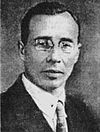
Nikolay Urvantsev
(1893–1985)
 Russian Empire
Russian Empire
 Soviet Union
Soviet Union
geologist, Arctic explorerUrvantsev was among the discoverers of a coal basin and a copper-nickel ore region in Norilsk in 1919-22 and was among the founders of Norilsk town. In 1922 he found evidence of the mysteriously disappeared Amundsen's 1918 Arctic expedition crew members Peter Tessem and Paul Knutsen on the Kara Sea shore. In 1930-32 Urvantsev and Georgy Ushakov explored and completely mapped the Severnaya Zemlya and established that it was an archipelago, discovering a number or islands and obliterating enormous "white spaces" on the Arctic map. Urvantsev also explored Taimyr and Central Siberian Plateau. In 1933-34 aboard the Pravda Urvantsev led the first Arctic oil exploration expedition to Nordvik (Laptev Sea).[3][12] 
Georgy Ushakov
(1901–1963)
 Russian Empire
Russian Empire
 Soviet Union
Soviet Union
geographer, Arctic explorerIn 1926 Ushakov founded the first Soviet settlement on the Wrangel Island. In 1930-32 Ushakov and Nikolay Urvantsev explored and completely mapped the Severnaya Zemlya and established that it was an archipelago. Severnaya Zemlya was a last archipelago on Earth to be explored. In 1935-36 Ushakov led the first Soviet high-latitude expedition on an icebreaker Sadko, examined the last unexplored areas in the northern Kara Sea and discovered Ushakov Island, the last unknown island in the Russian Arctic outside any archipelago. In 1937 Sadko was ice-trapped and wintered in the Laptev Sea. Ushakov died in Moscow, but was buried in Severnaya Zemlya.[147]
Mountains in the Antarctica, a spit, a cape and a settlement on Wrangel Island, a river in Severnaya Zemlya, and Ushakov Island bear Ushakov's name.Location of Ushakov Island
Tatyana Ustinova
(1913–2009)
 Russian Empire
Russian Empire
 Soviet Union
Soviet Union
 Canada
Canada
geologist, explorer of KamchatkaIn 1940 Ustinova came to Kronotsky Nature Reserve in Kamchatka. In 1941, with the help of the local guide Anysyfor Krupenin, she discovered the Valley of Geysers, the second largest concentration of geysers in the world. She researched the geysers until 1946 and gave the names to the most notable of them. Before she died, in a testament she wished that her ashes were buried in the Valley of Geysers.[148]  Valley of Geysers in Kamchatka
Valley of Geysers in Kamchatka
V
Contents: Top · 0–9 A B C D E F G H I J K L M N O P Q R S T U V W X Y Z
Portrait Person Achievements Image Merkury Vagin
(?–1712)
 Tsardom of Russia
Tsardom of Russia
Siberian Cossack, seafarer, merchant, Arctic explorerIn 1712, Vagin and his companion Yakov Permyakov crossed the Yana Bay from the mouth of the Yana over the ice and explored Bolshoy Lyakhovsky island, the southernmost of the New Siberian Islands (the island was sited two years earlier by Permyakov). From Bolshoy Lyakhovsky they spotted Maly Lyakhovsky island. Thus they initiated the exploration of the large New Siberian archipelago. On the way back Permyakov and Vagin were murdered by mutineering expedition members.[149]
Merkuriya Island in the Arctic was named after Merkury Vagin. Location of the New Siberian Islands
Location of the New Siberian Islands
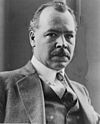
Nikolai Vavilov
(1887–1943)
 Russian Empire
Russian Empire
 Soviet Union
Soviet Union
botanist and geneticist,explorer of the centres of origin of cultivated plantsVavilov devoted his life to the study and improvement of wheat, corn, and other crops that sustain the global population. In 1924-35 he was the director of the All-Union Institute of Agricultural Sciences at Leningrad. Vavilov organized a series of botanical-agronomic expeditions, collected seeds from every corner of the globe, and created the world's largest collection of plant seeds in Leningrad. As a result of his long work and explorations he identified the centres of origin of main cultivated plants. During his journeys he had visited a number of virtually unknown regions of the world.[150]
N.I. Vavilov Institute of Plant Industry in St. Petersburg, the Vavilov Award and the Vavilov Medal of the USSR Academy of Sciences, Vavilovian mimicry, Vavilov Center, many plant species, scientific institutions, streets and settlements are named after Nikolai Vavilov. A meteostation and a glacier in October Revolution Island (Severnaya Zemlya), a minor planet 2862 Vavilov and the Vavilov crater on the Moon are also named after him and his brother physicist Sergey Vavilov. Vavilov Centers: the origin of cultivated plants
Vavilov Centers: the origin of cultivated plants

Boris Vilkitsky
(1885–1961)
 Russian Empire
Russian Empire
 United Kingdom
United Kingdom
 Belgium
Belgium
Russian Imperial Navy officer, hydrographer, Arctic explorerIn 1913-15 Vilkitsky led the Arctic hydrographic expedition on the icebreakers Taimyr and Vaigach, exploring the parts of the Northern Sea Route. In 1913, the expedition discovered Severnaya Zemlya, the last archipelago on Earth to be explored. Vilkitsky Island also was discovered then, as well as Maly Taymyr and Starokadomsky Islands. In 1914-15, Vilkitsky's expedition made the first through voyage from Vladivostok to Arkhangelsk, discovered Novopashenniy Island (now Zhokhova Island), and described the southern coastline of Severnaya Zemlya. In 1920 Vilkitsky emigrated to Britain. Later he led commercial expeditions in the Kara Sea and was employed as a hydrographer in the Belgian Congo.[151]
Vilkitsky Strait between Severnaya Zemlya and Taimyr Peninsula, Vilkitsky bay of Novaya Zemlya, two different Vilkitsky Islands subgroups of the Komsomolskaya Pravda Islands and Nordenskjold Archipelago, Vilkitsky Island (Kara Sea), Vilkitsky Island (East Siberian Sea) and other objects were named after Vilkitsky.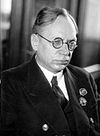
Vladimir Vize
(1886–1954)
 Russian Empire
Russian Empire
 Soviet Union
Soviet Union
oceanographer, Arctic explorerIn 1912-14 Vize took part in the Georgiy Sedov's expedition to Novaya Zemlya and Franz Josef Land. In 1924 he studied the drift of Georgy Brusilov's ill-fated Russian ship St. Anna, trapped on the pack ice. As a result of this study he predicted the location of yet unseen Vize Island, based on the analysys of ice movement in the Kara Sea. Vize took part in a number of Soviet polar expeditions, including the first successful crossing of the Northern Sea Route in a single navigation on icebreaker Sibiryakov in 1932. In 1938-40 Vize conducted the scientific research on the ice-captured icebreaker Sedov, turned into a drifting ice station.[3]
Vize Island in the Kara Sea, a bay, a glacier and a point on Novaya Zemlya, and a scientific vessel have been named after Vize.Vladimir Voronin
(1890–1952)
 Russian Empire
Russian Empire
 Soviet Union
Soviet Union
Soviet Navy captain, Arctic explorerIn 1932 Voronin commanded the expedition of the Soviet icebreaker Alexander Sibiryakov which made the first successful crossing of the Northern Sea Route in a single navigation without wintering. In 65 days Sibiryakov sailed from Archangelsk to Yokohama in Japan, having covered more than 2500 miles in the Arctic seas. In 1933-34 Voronin commanded less fortunate Cheliuskin steamship with scientific expedition of Otto Schmidt aboard. The sheep became ice-bound in the Chukchi Sea, but almost all the crew was resqued by planes from their camp on ice.[152]
Voronina Island in the Kara Sea, Voronina shoal in the Gulf of Finland, Voronin bay at Novaya Zemlya, underwater Voronin Trough in the Arctic basin.W
Contents: Top · 0–9 A B C D E F G H I J K L M N O P Q R S T U V W X Y Z
Portrait Person Achievements Image 
Ferdinand von Wrangel
(1797–1870)
 Russian Empire
Russian Empire
(born in Estonia, Baltic German descent)
Russian Imperial Navy officer, Admiral, Arctic explorerFerdinand Petrovich Wrangel took part in Vasily Golovnin's world cruise on the ship Kamchatka in 1817-19. Subsequently Wrangel led the Kolymskaya expedition in 1820-24 in search of northern lands. He established that north of the Kolyma River there was an open sea, not dry land, as previously thought. Together with Fyodor Matyushkin and P. Kuzmin, Wrangel described the Medvyezhi Islands and East Siberian Sea coastline from the Indigirka River to the Kolyuchinskaya Bay in the Chukchi Sea. After noticing swarms of birds flying north and questioning the native population, he determined that there must be an undiscovered island in the Arctic Ocean. Even though his search for it was unsuccessful the island was later named Wrangel Island to honour his endeavor. Wrangel led the Russian world voyage on the ship Krotky in 1825-27. He was the governor of Russian America in 1829-35, the president of the Russian-American Company in 1840-49 and the Minister of the Navy in 1855-57. In 1845 he became one of the founders of the Russian Geographic Society.[153]
Wrangel Island north of Chukotka, Wrangell Island in Alexander Archipelago near Alaska and a city there, Wrangell Narrows channel in the Alexander Archipelago, Cape Wrangell of Attu Island (the westernmost point of Alaska and the continental USA) and Mount Wrangell (a volcano in Alaska) were named after Wrangel.Y
Contents: Top · 0–9 A B C D E F G H I J K L M N O P Q R S T U V W X Y Z
Portrait Person Achievements Image 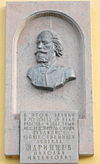
Nikolai Yadrintsev
(1842–1894)
 Russian Empire
Russian Empire
public figure, archaeologist, and turkologist, explorer of Siberia and Central AsiaUnder a contract with Russian Geographical Society, Yadrintsev twice traveled across Siberia and Altai, researching economy and geography, archeology and ethnography, anthropology and linguistics. In 1889 he located the remains of medieval city Hara-Balgas and the Genghis Khan's capital Karakorum in Mongolia. In the valley of the Orkhon River Yadrintsev discovered the Orkhon script of ancient Türks on two petroglyphic monuments with runiform writing, later decoded by the Danish scientist Vilhelm Thomsen. In 1891 Yadrintsev took part in the expedition led by turkologist academician Vasily Radlov, finding more monuments of Türkic runiform writing.[154]
A number of streets in Siberian cities and a settlement in Omsk Oblast were named after Yadrintsev.
Yermak Timofeyevich
(1532-42 – 1585)
 Grand Duchy of Moscow
Grand Duchy of Moscow
 Tsardom of Russia
Tsardom of Russia
Cossack ataman, folk hero, explorer of West Siberia and conqueror of Siberia KhanateAround 1577, the merchants Stroganovs, who were the main colonisers of the Urals, hired the Cossack leader Yermak to protect their lands from attacks of the Siberian Khan Kuchum. In 1581 Yermak began his voyage into the depths of Siberia. After a few victories over the khan's army, Yermak's people defeated Kuchum's main forces on Irtysh River after a 3-day battle Battle of Chuvash Cape in 1582. The remains of the khan's army retreated to the steppes and Yermak captured the Siberia Khanate, including its capital Qashliq near modern Tobolsk. Kuchum still was strong and suddenly attacked Yermak in 1585 in the dead of night, killing most of his people. Yermak was wounded and tried to swim across the Wagay River (Irtysh's tributary), but drowned under the weight of his own chain mail. Russians had to withdraw from Siberia completely, but thanks to Yermak's having explored all the main river routes of central West Siberia, they successfully returned all Yermak's conquests just several years later.[135]
Yermak, the first true icebreaker able to crush pack ice, was named after Yermak, as well as Yermak Stone in Perm Krai and a number of streets and settlements. Yermak's life and death have been subjects for numerous Russian songs, books, and paintings since the 16th century. In 1995 a historical biopic Yermak was shot.Ivan Yevreinov
(?–1724)
 Poland-Lithuania
Poland-Lithuania
 Tsardom of Russia
Tsardom of Russia
 Russian Empire
Russian Empire
cartographer, geodesist, explorer of Siberia and the Russian Far EastIn 1719-1721, together with Fyodor Luzhin, Yevreinov made the first instrumental mapping of Kamchatka and the first map of the Kuril Islands during the "secret expedition", as ordered by Peter I of Russia. In 1723-24 he mapped Khlynov region near Vyatka.[155]
A strait between Makanrushi and Onekotan in the Kurils, a mountain, and a peninsula in the Okhotsk Sea are named after Yevreinov. Northern Kurils, showing Yevreinov and Luzhin Straits
Northern Kurils, showing Yevreinov and Luzhin Straits
Z
Contents: Top · 0–9 A B C D E F G H I J K L M N O P Q R S T U V W X Y Z
Portrait Person Achievements Image 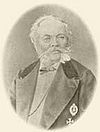
Lavrenty Zagoskin
(1808–1890)
 Russian Empire
Russian Empire
Russian Imperial Navy officer, naturalist, explorer of AlaskaCommissioned by Russian America Company, in 1842-44 Zagoskin traveled extensively in Alaska, covering more than 3300 miles. He explored and mapped the Yukon, Kuskokwim, Innoko and Koyukuk Rivers, researched the native peoples and nature of the region. He published the first detailed description of the inner areas of Alaska.[156]
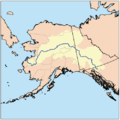 Yukon River basin
Yukon River basin
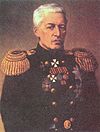
Vasily Zavoyko
(1809–1898)
 Russian Empire
Russian Empire
Russian Imperial Navy officer, Admiral, circumnavigator, explorer of the Russian Far EastIn 1835–38 Zavoyko twice circumnavigated the globe. After 1840, during his service for the Russian-American Company in the Okhotsk Sea, Zavoyko explored the estuary of the Amur River. His reports led to further expeditions and ultimately the incorporation of Primorsky Krai into Russia. In 1854, at the time of Crimean War, as a governor of Kamchatka Zavoyko led the successful defence during the Siege of Petropavlovsk. He repelled the superior allied British-French forces and even captured the British banner. In 1855, making the way through the frozen seas and successfully avoiding the large enemy fleet, he supervised the transfer of the Russian Pacific Fleet from Petropavlovsk to Nikolayevsk-on-Amur.[157]
A settlement near Petropavlovsk-Kamchatsky (now a city district) is named after Zavoyko. Modern view of Petropavlovsk on Kamchatka
Modern view of Petropavlovsk on Kamchatka
See also
- 1966 Soviet submarine global circumnavigation
- Arctic policy of Russia
- First Russian circumnavigation
- Geography of Russia
- Great Northern Expedition
- List of explorers
- List of Russian Admirals
- List of Russian aviators
- Northern Sea Route
- Russian culture
- Russian Geographical Society
- Soviet Antarctic Expeditions
- Siberian river routes
- Soviet space program
References
- ^ a b c Valerian Albanov. In the Land of White Death
- ^ a b c d e f g h i Russian Biographical Dictionary
- ^ a b c d e f g h i j k l m n Great Soviet Encyclopedia
- ^ a b Dictionary of Scientific Biography
- ^ Vladimir Klavdievich Arsenyev and his heritage by Sergey Krivoshenko (Russian)[dead link]
- ^ Russian historians about Vladimir Atlasov by N.V. Tolkacheva (Russian)
- ^ Armstrong, T., The Russians in the Arctic, London, 1958.
- ^ Early Soviet Exploration of Arctic
- ^ Heroes of the country (Russian)
- ^ Chevigny, Hector; Lord of Alaska - Baranov and the Russian adventure, Portland, Oregon, Binfords & Mort, 1951, LIBRIS-id 2331138
- ^ Geographical discoveries of N.A.Begichev on Taymyr by V.A.Troitsky (Russian)
- ^ a b William Barr, The Last Journey of Peter Tessem and Paul Knutsen, 1919
- ^ History of Chita (Russian)
- ^ Allworth, Edward (1994). Central Asia, 130 Years of Russian Dominance. Duke University Press. p. 9. ISBN 978-0-8223-1521-6.
- ^ 70South - information on Fabian von Bellingshausen[dead link]
- ^ Bellingshausen's biography (Russian)
- ^ Lev Berg - article in the Encyclopedia Britannica
- ^ a b c d e f Encyclopædia Britannica Eleventh Edition
- ^ PBS story of Bering's expedition
- ^ Bering, Vitus(Russian)
- ^ Biography at the Dictionary of Canadian Biography Online
- ^ Article about Bulatovich on the site of Russian orthodox Church(Russian)
- ^ Article on the site geographia.ru(Russian)
- ^ Александр Андреевич Бунге - А.К. Сытин ; отв. ред. Р.В. Камелин.—М. : Наука, 2006.—ISBN 978-5-02-035310-7 (Russian)
- ^ a b c Vasily Pronchishev and Semion Chelyuskin (Russian)
- ^ John J. Stephan, The Russian Far East: A History, Stanford University Press, 1994, ISBN 978-0-8047-2701-3, Google Print, p.315
- ^ A. Sokolov. Lomonosov's Project and Chichagov's Expedition. SPb, 1854
- ^ Biography of Chikhachyov at hrono.ru (Russian)
- ^ Chilingarov at Heroes of the Country (Russian)
- ^ Biography of Chirikov(Russian)
- ^ Chkalov on the site "Heroes of the country" (Russian)[dead link]
- ^ a b c Raymond H Fisher, The Voyage of Semen Dezhnev in 1648, The Hakluyt Society, 1981
- ^ The Finns in America by Taru Spiegel, Reference Librarian. The Library of Congress
- ^ Mearns and Mearns - Biographies for Birdwatchers ISBN 978-0-12-487422-0
- ^ Robert Middleton and Huw Thomas, "Tajikistan and the High Pamirs", Odyssey Guides, 2008
- ^ Fersman Memorial
- ^ Fyodorov biography at Kapustin library (Russian)
- ^ Finnish Place Names - Alaska
- ^ Yuri Gagarin - The First to Fly
- ^ Biography of Georgi(Russian)
- ^ Gmelins family(Russian)
- ^ How Sloop Diana, commanded by Lieutenant Vasilii M. Golovnin, eluded the British fleet at Simon's Bay[dead link]
- ^ Peter Hopkirk. The Great Game
- ^ Gvozdev biography at Kapustin library(Russian)
- ^ Gvozdev biography at the site of Kamchatka Krai(Russian)
- ^ Hagemeister biography
- ^ Ivanov, Kurbat (Russian)
- ^ Тропою землепроходцев (Russian)
- ^ Biographical Dictionary of the Russian Far East and Russian America(Russian)
- ^ Werner Friedrich Gülden (editor): Forschungsreise nach Kamtschatka – Reisen und Erlebnisse des Johann Karl Ehrenfried Kegel von 1841 bis 1847, Böhlau-Verlag, 1992, ISBN 978-3-412-11091-8 (German)
- ^ a b Basil Dymytryshyn, 'Russia's Conquest of Siberia', 1985
- ^ Khabarov's biography (Russian)[dead link]
- ^ "Sixteenth Meeting of the GEBCO Subcommittee on Undersea Feature Names". International Hydrographic Organization. April 2002. http://www.gebco.net/about_us/meetings_and_minutes/documents/gebco_scufn_16_report.pdf. Retrieved 2007-11-15.
- ^ Hrono.info
- ^ a b c William Barr, Baron Eduard von Toll's Last Expedition: The Russian Polar Expedition, 1900-1903. 1980
- ^ Biography at Konyukhov's official site
- ^ Antarctica Cup site
- ^ Kozlov's biography(Russian)
- ^ Krasheninnikov's biography (Russian)
- ^ NASA biography of S. Krikalyov
- ^ Pyotr Kropotkin by N.M.Pirumova (Russian)
- ^ Aleksandr Stepanovich Kuchin: The Russian who went South with Amundsen by William Barr
- ^ Still Amazing Amazonia (Russian)
- ^ a b The cousins Dmitry Yakovlevich and Khariton Prokofyevich Laptev(Russian)
- ^ George Alexander Lensen, “Early Russo-Japanese Relations”, The Far Eastern Quarterly, vol.10, no.1, November 1950, pp.2-37, n.b. pp.17-22
- ^ List of Russian explorers at Find a Grave
- ^ Scott, David; Alexei Leonov (2006). Two Sides of the Moon: Our Story of the Cold War Space Race. with Christine Toomey. St. Martin's Griffin. ISBN 978-0-312-30866-7.
- ^ Levashov's biography (Russian)
- ^ Biography of Lisyansky(Russian)
- ^ Biography of Litke by B.P.Orlov (Russian)
- ^ Biography of Luzhin(Russian)
- ^ D. Gath Whitley: The Ivory Islands in the Arctic Ocean, Journal of the Philosophical Society of Great Britain XII, 1910
- ^ Maack's biography (Russian)
- ^ Makarov's biography at peoples.ru (Russian)
- ^ Malygin's biography at polarmuseum.ru (Russian)
- ^ Fyodor Fyodorovich Matyushkin at findagrave.com
- ^ Middendorff's biography at hrono.ru (Russian)
- ^ Ogloblin, A. K. (1998) 'Commemorating N.N. Miklukho-Maclay (Recent Russian publications)', in Perspectives on the Bird's Head of Irian Jaya, Indonesia: Proceedings of the Conference, pages.487–502. 1998. ISBN 978-90-420-0644-7. Partial view on Google Books
- ^ Урсул Д. Т. Николай Гаврилович Милеску-Спафарий. М.: Мысль, 1980. / Ursul D.T. Nikolai Gavrilovich Milescu-Spathari. Moscow: Mysl, 1980. (Russian)
- ^ Minin's biography(Russian)
- ^ Moskvitin's biography at hrono.ru (Russian)
- ^ G.-F. Müller and the Imperial Russian Academy, J. L. Black, 1986
- ^ Vladimir Barayev, "Николай Николаевич Муравьёв-Амурский" (Nikolay Nikolayevich Muravyov-Amursky). Алфавит (Alfavit) newspaper, No. 30, 2000 (Russian)
- ^ a b c d e Brockhaus and Efron Encyclopedic Dictionary (Russian)
- ^ Mushketov's biography(Russian)
- ^ A.B. Grigoriev (1989). Альбатросы: Из истории гидроавиации (Albatroses: from the history of hydroaviation). Moscow: Машиностроение. p. 272. ISBN 978-5-217-00604-5. http://militera.lib.ru/tw/grigoryev/01.html.
- ^ Nevelskoy's biography at peoples.ru (Russian)
- ^ Nikitin - The first Russian traveler to India by Dr. Jyotsna Kamat
- ^ Obruchev's biography (Russian)
- ^ Ovtsyn's biography(Russian)
- ^ Pakhtusov's biography(Russian)
- ^ Pallas's biography at free-time.ru/[dead link]
- ^ Papanin's biography at hrono.ru (Russian)
- ^ The Perfilyevs family(Russian)
- ^ Тропою землепроходцев(Russian)
- ^ Russian polar seafarers of XVII-XVIIIth cc. by Vladimir Vize (Russian)
- ^ Mark Mancall, Russia and China: Their Diplomatic Relations to 1728, 1971.
- ^ Staying Put on Earth, Taking a Step to Mars
- ^ a b c Frigate Pallada in Japan and the Friendship Treaty between Japan and Russia[dead link]
- ^ Posyet's biography at funeral-spb.narod.ru (Russian)
- ^ Potanin's biography at siberianclub.ru (Russian)[dead link]
- ^ Poyarkov's biography at hrono.ru (Russian)
- ^ Black, Lydia. Russians in Alaska, 1732-1867. pg. 104. http://books.google.com/books?id=NSRxrDm0JYYC&pg=PA102&lpg=PA102&dq=Pribilof+Shelikhov&source=bl&ots=McLg3D1JDd&sig=d9awmbjITx45_TAcCIQ4VvkH4uQ&hl=en&sa=X&oi=book_result&resnum=1&ct=result#PPA104,M1.
- ^ "Pribilof Islands Restoration Project Historical Overview". NOAA. November 10, 2005. http://response.restoration.noaa.gov/topic_subtopic_entry.php?RECORD_KEY(entry_subtopic_topic)=entry_id,subtopic_id,topic_id&entry_id(entry_subtopic_topic)=180&subtopic_id(entry_subtopic_topic)=12&topic_id(entry_subtopic_topic)=2. Retrieved January 22, 2009.
- ^ Przhevalsky's biography at hrono.ru (Russian)
- ^ The discovery of Central and Eastern Siberia by Russians (Russian)
- ^ The 17th-century Siberia seen by a man of the times. S.U. Remezov and his "Siberian History", many illustrations (Russian)
- ^ * Rezanov online museum (Russian)
- ^ Voin Rimsky-Korsakov's biography at biografija.ru (Russian)]
- ^ a b International Centre of the Roerichs (Moscow)
- ^ L.V.Shaposhnikova. From Altai to Himalayas. Along the path of Central-Asian Expedition of N. Roerich. – Moscow, International Centre of the Roerichs, Master-Bank, 1998.
- ^ Participants, chronology, bibliography of Central-Asian Expedition of N. Roerich are on the website of International Centre of the Roerichs.
- ^ Rusanov's biography
- ^ Webpage of Rusanov's museum in Oryol (Russian)
- ^ S.V. Popov "Autographs on the charts"- Arkhangelsk, 1990 ISBN 978-5-85560-153-4
- ^ Alexander Nevsky at pereslavl.info (Russian)
- ^ Deep Ocean Expeditions[dead link]
- ^ DivingAlmanac.com[dead link]
- ^ Samoylovich's biography (Russian)
- ^ Sannikov's biography (Russian)
- ^ Sarychev's biography at npacific.ru (Russian)
- ^ Biography of Savitskaya at astronaut.ru (Russian)
- ^ Otto Schmidt at the Heroes of the Country(Russian)
- ^ Semyonov's biography at biografia.ru (Russian)
- ^ Senkevich's biography at planetguide.ru (Russian)[dead link]
- ^ Shelikhov's biography (Russian)
- ^ Shkot's biography (Russian)
- ^ Biography of Shokalsky (Russian)
- ^ Shpanberg's biography at kamchatsky-krai.ru (Russian)
- ^ Yurii Semenov. Siberia: Its Conquest and Development. (Translated from the German by J.R. Foster). Helicon Press, Baltimore, 1963.
- ^ Wade, Mark (2008). "Solovyev web page". Encyclopedia Astronautica. http://www.astronautix.com/astros/solovyov.htm. Retrieved January 12, 2009.
- ^ NASA Biography of Anatoly Solovyev
- ^ Somov's biography at aari.nw.ru (Russian)
- ^ Steller's biography at beringisland.ru (Russian) Archived 1 February 2010 at WebCite
- ^ a b "Yermak. The Conquest of Siberia" (in Russian). Кольцо Сибири. http://ring-siberia.ru/ermak. Retrieved 2011-04-05.
- ^ "Татищев Василий Никитич [Vasily Nikitich Tatishchev]" (in Russian). hrono.ru. http://www.hrono.ru/biograf/bio_t/tatishev_vn.php. Retrieved 2011-04-19.
- ^ "The Naming of Alaska". ExplorationNorth. http://explorenorth.com/library/history/geodic-ak-1902-T.html. Retrieved 2011-04-19.
- ^ "Biography of Tereshkova". Administration of the Yaroslavl Region. http://www.adm.yar.ru/english/section.aspx?section_id=74. Retrieved 2011-04-19.
- ^ "Тилло Алексей Андреевич [Aleksey Andreyevich Tillo]" (in Russian). Brockhaus and Efron Encyclopedic Dictionary. http://www.vehi.net/brokgauz/index.html. Retrieved 2011-04-19.
- ^ "Титов Герман Степанович [Gherman Stepanovich Titov]" (in Russian). Герои Страны. http://www.warheroes.ru/hero/hero.asp?Hero_id=638. Retrieved 2011-04-19.
- ^ "Толстиков Евгений Иванович [Yevgeny Ivanovich Tolstikov]" (in Russian). Герои Страны. http://www.warheroes.ru/hero/hero.asp?Hero_id=4737. Retrieved 2011-04-19.
- ^ "Ф.И. ТОЛСТОЙ - АМЕРИКАНЕЦ [F.I. Tolstoy – American]" (in Russian). Русский журнал. http://magazines.russ.ru/slovo/2004/43/vv4.html. Retrieved 2011-04-19.
- ^ "Алексей Федорович Трешников (1914-1991) [Alexey Fedorovich Tryoshnikov]" (in Russian). aari.nw.ru. http://www.aari.nw.ru/projects/Antarctic/persons/treshnikov/treshnikov_ru.html. Retrieved 2011-04-19.
- ^ "Циволька Август Карлович [Avgust Karlovich Tsivolko]" (in Russian). Rulex. http://www.rulex.ru/01230064.htm. Retrieved 2011-04-19.
- ^ Jennifer Speake (2003). Literature of Travel and Exploration: An Encyclopedia. Fitzroy Dearborn. pp. 1199–1201. ISBN 978-1-57958-440-5. http://books.google.com/books?id=xku_Ik6E96MC&pg=PA1199&dq=tsybikov&hl=en&sig=ACfU3U3-mrLVzumJRGB6PweK4P1ykdgY9Q#PPA1199.
- ^ "Унковский Иван Семенович [Ivan Semenovich Unkovsky]" (in Russian). pgpb.ru. http://www.pgpb.ru/cd/primor/first/ynk.htm. Retrieved 2011-04-06.
- ^ "G.A.Ushakov's biography". skypole.ru. http://www.skypole.ru/ushakov/biogr_e.htm. Retrieved 2011-04-06.
- ^ "Татьяна Устинова [Tatyana Ustinove]" (in Russian). ФГУ Кроноцкий заповедник. http://www.kronoki.ru/territory/reserve/history/faces/86. Retrieved 2011-04-06.
- ^ "Вагин Меркурий [Merkury Vagin]" (in Russian). biografija.ru. http://www.biografija.ru/show_bio.aspx?id=14908. Retrieved 2011-04-06.
- ^ "Биографический указатель" (in Russian). hrono.ru. http://www.hrono.ru/biograf/bio_we/vavilov_ni.php. Retrieved 2011-04-06.
- ^ "Биографический указатель" (in Russian). hrono.ru. http://www.hrono.ru/biograf/bio_we/vilkicky.html. Retrieved 2011-04-06.
- ^ "Воронин Владимир Иванович [Vladimir Ivanovich Voronin]" (in Russian). biografija.ru. http://www.biografija.ru/show_bio.aspx?id=19688. Retrieved 2011-04-06.
- ^ "Врангель, Фердинанд Петрович [Ferdinand Petrovich Wrangel]" (in Russian). Brockhaus and Efron Encyclopedic Dictionary. http://www.vehi.net/brokgauz/index.html. Retrieved 2011-04-05.
- ^ "Yadrintsev's biography" (in Russian). altaiinter.info. http://www.altaiinter.info/project/culture/Researchers/Personnels/Jadrincev/jadr01.htm. Retrieved 2011-04-05.
- ^ "Евреинов Иван Михайлович" (in Russian). npacific.ru. http://www.npacific.ru/np/library/encicl/6/0001.htm. Retrieved 2011-04-05.
- ^ Henry N. (1967). Lieutenant Zagoskin's Travels in Russian America. University Of Toronto Press. ASIN B000J00FME.
- ^ "Завойко [Savoyko]" (in Russian). Brockhaus and Efron Encyclopedic Dictionary. http://www.vehi.net/brokgauz/index.html. Retrieved 2011-04-05.
Exploration and explorers by nation or region Explorers by country Explorers by type Circumnavigators · Climbers · Desert explorers · Polar explorers · Seafarers · Space travelers · Undersea explorersExploration by region Asia · Central Asia · Africa · Australia · North America · South America · Oceania · Space explorationExploration timelines People from Russia Leaders and religious - Pre-1168
- 1168–1917
- 1922–1991
- 1991–present
- RSFSR leaders
- General secretaries
- Soviet premiers (1st deputies)
- Soviet heads of state (and their spouses)
- Prime ministers (1st deputies)
- Foreign ministers
- Prosecutors general
- Metropolitans and patriarchs
- Saints
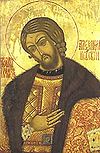
Military and explorers - Field marshals
- Soviet marshals
- Admirals
- Aviators
- Cosmonauts
Scientists and inventors - Aerospace engineers
- Astronomers and astrophysicists
- Biologists
- Chemists
- Earth scientists
- Electrical engineers
- IT developers
- Linguists and philologists
- Mathematicians
- Naval engineers
- Physicians and psychologists
- Physicists
- Weaponry makers
Artists and writers Sportspeople Chess playersCategories:- Russian people
- Russian explorers
- Explorers by nationality
- Lists of Russian people
- Lists of explorers
Wikimedia Foundation. 2010.


















